Dental X-Rays are a central part of your dentist’s toolkit for taking care of your oral health. If you’ve maintained a steady oral health care routine that involves visits to your dentist, you’ve likely had dozens of them in your lifetime. While critical in pediatric dentistry, they remain an important diagnostic component in adults as well. There’s nothing better for getting a clear view of a patient’s overall oral health, especially those components that can be hidden from the naked eye. There are numerous types of dental x-rays, we’re going to talk about the most common ones.
This form of X-Ray provides an unparalleled view of a whole side of a patient’s oral structures. The area revealed is from the crown to the roots in the jawbone and can be a powerful diagnostic tool for bone density changes and decay. When restorations are being ordered, they’re also essential in getting a perfect fit and can be used to inspect fillings for integrity.
There are times when your dentist requires an image of a full dental arch. It’s at these times that an occlusal x-ray is ordered, often to determine the placement of a patient’s teeth or to discern the development of the same. This makes them a common part of pediatric dentistry, but there are times when it’s important for adult dentistry as well.
When it comes time for a root canal performed, this is one form of dental x-ray, you can count on being ordered. The purpose of a periapical x-ray is to provide a complete image of a single tooth. Every part of your tooth, from the roots set in the jawbone to the crown that caps it, will be visible, including their internal structures. Its ability to reveal abnormalities in your tooth’s structure helps the dentist prepare for clearing out the pulp and performing a successful root canal treatment.
When your dentist needs to isolate a single area of your mouth from the surrounding structures, they choose to use a tomogram x-ray. These x-rays focus on just one area, blurring out all the surrounding structures so the dentist can focus on that one point.
Your dentist is also responsible for monitoring the health of your salivary glands. When something is suspected of having gone awry, they may opt to perform a sialography. This form of imaging starts with a dye injection into the salivary glands to help them show up on the x-ray. This is followed by imaging that will help your dentist see any abnormalities that may appear in their structure.
Dental x-rays are a routine and safe practice performed in dental practices across the United States every day. The already safe and low amounts of radiation are, with improving technology, being reduced even further. Contact Dr. Sam S Sadati at the Sadati Center For Aesthetic Dentistry to learn more about dental imaging and how it’s used as a part of our practice. We’re excited to welcome you to our offices in Wellington, FL!
Root canal treatments are a second-to-last resort for protecting teeth from further damage and decay. Root canals can even be needed when there’s no pain present. If your dentist informed you that you need a root canal, it’s probably to help save your tooth because your tooth’s probably infected. Suppose you still find yourself wondering why you need a root canal and whether or not it’s necessary. In that case, we’re here to help inform you of the risks associated with your infected tooth, how root canals are performed, and why they’re sometimes a necessary procedure for protecting teeth.
Cavities, or tooth decay, are created the buildup of bacteria over time. This bacteria generally forms a sticky, filmy substance called plaque, and that plaque can be hard to clean when left on the tooth for long periods. This bacterial substance, along with un-brushed food particles and sugar, can cause the tooth’s enamel to wear down, reaching down into the dentin and then the root of the tooth and decays the pulp of the tooth over time. Because of the plaque’s acidic quality, the bacteria within the plaque can hit the tooth’s nerves, causing pain and inflammation.
For some, the signs of decay don’t come with pain, because the tooth may also be decayed so drastically that the bacteria destroy the nerve root of the tooth. However, the most common signs of a cavity include:
In its advanced stages, cavities can develop abscesses or pimple-like pockets of infection that indicate an extremely high risk of tooth loss because the infection has since reached into the pulp and root of the tooth and has taken hold of the tooth’s lifeline to the jawbone. If left untreated during this time, tooth loss can occur, and an extraction may be needed to save the integrity of the jaw and the adjacent teeth.
A root canal procedure helps remove the tooth’s infection and saves it from harmful, long-term damage. Root canals are an endodontic treatment that focuses on severe tooth decay and can be performed by a primary dentist or an endodontist. For patients with severe tooth decay, the decay area is first cleaned out using numbing material, drills, and files to clear away any damaged pulp and an antimicrobial solution to clear out any leftover bacteria present. Once the chamber is cleared, the dentist will fill the tooth with thermoplastic latex resin called gutta-percha, close the area with a filling or crown to protect the root from future infections.
By providing these special cleanings, dentists can save the tooth’s integrity without approaching the next phase of treatment, which would involve removing the tooth entirely. The tooth’s restorations will protect the root from damage and protect the rest of your natural teeth from any future infections.
To learn about root canal treatments, and see if you qualify for a root canal, contact Dr. Sam S. Sadati at The Sadati Center for Aesthetic Dentistry in Wellington, FL to schedule an appointment and learn about the various ways Dr. Sadati can treat your cavity and give you a proper restoration today.
Missing teeth have a significant impact on our lives; over 50% of people in the United States miss at least one tooth due to gum disease, tooth decay, or a traumatic injury, and missing teeth are felt everywhere. The answers to replacing missing teeth can appear obvious to anyone. Still, we don’t usually think about the long-term consequences for everyday people that can occur with missing even just one tooth. Missing teeth can not only affect one’s confidence in their appearance but affect their overall physical and mental health. Here are the reasons why we suggest heading to your dentist for a tooth replacement!
All of these issues affect people’s lives every day, and today’s modern dental technology can treat these issues by replacing the tooth entirely. Whether it’s a single tooth or your full arch, dentists can completely restore the mouth with numerous restorative devices and methods, such as:
If you’re missing teeth and wish to reduce your risks, talk with Dr. Sam S. Sadati at The Sadati Center for Aesthetic Dentistry in Wellington, FL, for more information on how we can treat your teeth.
Have you ever been experiencing dental pain and been convinced that you may need a tooth extracted? You may be jumping the starting line. When you’re working with a dentist, you can believe that every necessary step will be taken to protect and maintain your natural teeth. Extraction of your tooth is an option of last resort in most cases, only suggested when no other treatment promises to save the tooth. In many situations, there are options available that will allow you to retain your natural tooth, which is the preferred result from a dentist’s perspective.
While the concept of having a tooth pulled may seem simple on the surface, there is more than one type of dental extraction. The most common one that we’re all familiar with is the simple extraction. During this procedure local anesthetic is usually applied, and removal of the tooth is accomplished in only a scant few minutes in many cases. Lifters and a special pair of grips are used to remove the tooth and any remaining fragments from the socket.
The other, less common form, is surgical extraction. Surgical extraction becomes necessary when the tooth in question is lodged within the bone, or in an area that cannot be reached with traditional tools. This form of extraction is typically done while the patient is under full anesthesia, known as general anesthesia.
So if a dentist’s first goal is to retain your natural teeth, what would make them suggest an extraction? The most common answer involves advanced decay or trauma that has done sufficient damage that the tooth cannot be saved.
These are the most common reasons that Dr. Sam S. Sadati may suggest you have a dental extraction performed. Before these steps are taken, all alternatives that will retain your natural teeth will be considered.
If you have more inquiries about dental extractions or are ready to schedule an appointment with Wellington Florida’s preeminent dental team, call today. Our team at The Sadati Center For Aesthetic Dentistry is ready to accept your call and schedule an appointment with Dr. Sadati. Don’t waste time waiting to visit our clinic! Acting now can help you avoid extraction and preserve your teeth for years to come!
Cosmetic dentures have the power and ability to change many lives; for those with missing teeth, tooth infections, and gum disease, dentures present an opportunity to get a new set of teeth that can transform smiles and improve confidence. If you’re one of these people, getting dentures may seem like an excellent, worthwhile investment. But getting dentures depends on many factors, and thanks to today’s technology, people with missing and crooked teeth have many options to choose from for dental restorations.
Dentures, or artificial teeth composed into a gum-like mold, come in many unique variations. The most popular forms are complete dentures, which cover the entire mouth and replace all the missing teeth not present in the mouth. Partial dentures work to cover only a segment of teeth, working together with the rest of your natural teeth to form a complete smile. Dentures can also occur with different materials, such as snap-in dentures, which use implant anchors as a support for partial or complete dentures, and implant-supported dentures, which use dental implants to support the denture frame. Some are removable, some are permanent, and it all depends on your needs and oral health on what your options present.
Acquiring dentures, again, depends on your oral health and the specific circumstances surrounding your teeth. However, there are some general qualifications that many dentists follow when working with a person in need of dental restorations. Some of those include:
However, there are other cases of missing teeth where dentures don’t apply. For instance, if you’re only missing a few teeth but otherwise have a healthy mouth, implants can provide better support for the surrounding teeth and fill in the missing gaps.
No matter your present situation, Dr. Sam S. Sadati at The Sadati Center for Aesthetic Dentistry can help. Dr. Sadati offers patients with numerous solutions for missing and broken teeth in the Wellington, FL area. If you feel like you need dentures, and wish to qualify, contact Dr. Sadati today to learn more and schedule an appointment.
Dental insurance has become a given for significant, expensive procedures. Modern dental practices have to adapt to their patient’s financial situations and give options for payment plans. Dental insurance can be the right choice for you if you want to make sure that you’re able to get the procedures you need without sacrificing hard-earned money and time. Dental insurance can be one of the smartest decisions anyone can make, and there are numerous benefits that come with having dental insurance as a backup.
If you’re interested in finding a dental insurance plan that fits your needs, here are some basic dental insurance facts that you should be aware of before making the investment.
Dental insurance is made to cover some of the most basic treatments, including cleanings, checkups, and procedures such as fluoride and dental sealants. At most, when you visit your dentist for an annual or six-month checkup, you should only spend at most $200 for one visit. This means that your dental insurance should cover at least 60% of the costs, and if you’re able to find one that covers 100% costs, then you’re golden.
Dental plans should cover at least 80% of the costs for restorative treatments, such as fillings, extractions, and repairs for crowns and bridges. Specific plans will only cover certain types of fillings and other restorative procedures, but by having this insurance, you can reduce the costs by only paying the 20%.
Not all services offered by dentists can be covered by your insurance. Treatments such as braces tend to result in out of pocket costs, meaning your need to purchase a rider policy to amend the terms of the policy to cover your dental care. Other services, such as restorative services, can be covered by your insurance by at least 50%, but will still cost you much more money out of pocket. Coverage in these cases is still valuable, and if you need these services to keep your teeth healthy, then it’s best to plan ahead and work with your dentist on how to best care for your dental health.
Depending on the type of dental treatment you need, your dental plan will need to process the payments by cooperating with the dental practice and its policy representatives. Specific procedures, such as those under preventative care, can take as little as 30 days, while others, such as essential restorative services, can take up to 3 months. With this in mind, you should be vigilant about your dental care and get the services you need so your insurance can process the payments.
At the Sadati Center for Aesthetic Dentistry, Dr. Sam S. Sadati can accept most insurance policies and will work with you on finding the most suitable solutions with the best outcomes. Located in Wellington, FL, Dr. Sadati has numerous treatment options for cosmetic solutions with a range of prices that can be affordable for all patients. Schedule a consultation today to learn more about Dr. Sadati’s services.
Careers have the potential to change someone’s life because caring about your career can give you valuable experiences that can dramatically affect the direction and course of your life. With new careers, you can experience new business relationships, friendships, and even romantic relationships down the road. However, one of the first steps to gaining a career is those pesky interviews that rattle your nerves and critic your portfolios. For those who have the opportunities to change their job title, changing the way you see your smile can help.
Cosmetic dentistry focuses on the aesthetically pleasing features of your teeth, improving its look and appearance to give people a happier, healthier smile. Cosmetic dentistry focuses on restoring the mouth’s integrity and structure through multiple avenues, and thus gives patients the ability to repair even the most crooked of teeth. But why teeth?
Cosmetic procedures can help brighten up your smile and give you the boost you need to improve your career. Some cosmetic treatments dentists offer to help with your smile can include:
Teeth Whitening – As a popular and common treatment, whitening treatments can instantly whiten your smile and make it look brighter without the intensive commitment. Teeth whitening treatments are especially good for special occasions and those ever-so-important interviews.
Porcelain Veneers – Veneers are custom-made shells that cover the front of the teeth, and help to erase any imperfections developed overtime. Porcelain veneers are made to match the color of your teeth and are permanently fixed to the teeth to correct minor gaps and irregularities found in the mouth.
Cosmetic Crowns – Crowns help protect the molars and front teeth by completely covering the tooth, and thus can help restore your smile’s natural appearance and strength.
Contact Dr. Sam S. Sadati at The Sadati Center for Aesthetic Dentistry, located in Wellington, FL, to schedule an appointment today.
When you have a tooth affected by damage or decay, you will need to visit your dentist’s office for restorative dental treatment. There are a variety of restorative dental treatments available that offer different options depending on the extent of the damage or decay. The one thing that all these restorative treatments have in common is that they use dental restorations to restore the function and appearance of the affected tooth.
A dental restoration simply refers to the method used to repair the damaged or decayed portion of the tooth. There are two different types of dental restorations: direct and indirect. As mentioned before, the type of restoration needed will depend upon the type of and extent of the damage, as well as its location. Let’s take a look at these two types of restorations to learn more about what differentiates them from one another.
A direct restoration refers to restorations that can be fabricated inside the mouth. These restorations can be completed during a single dental appointment because they do not require the use of a dental lab for fabrication. Instead, your dentist will place, shape, and harden the restoration in place during your appointment. Not only does this mean that you won’t need a temporary restoration or a second appointment to place the permanent restoration, but it also means that you won’t have the dietary restrictions associated with temporary restorations.
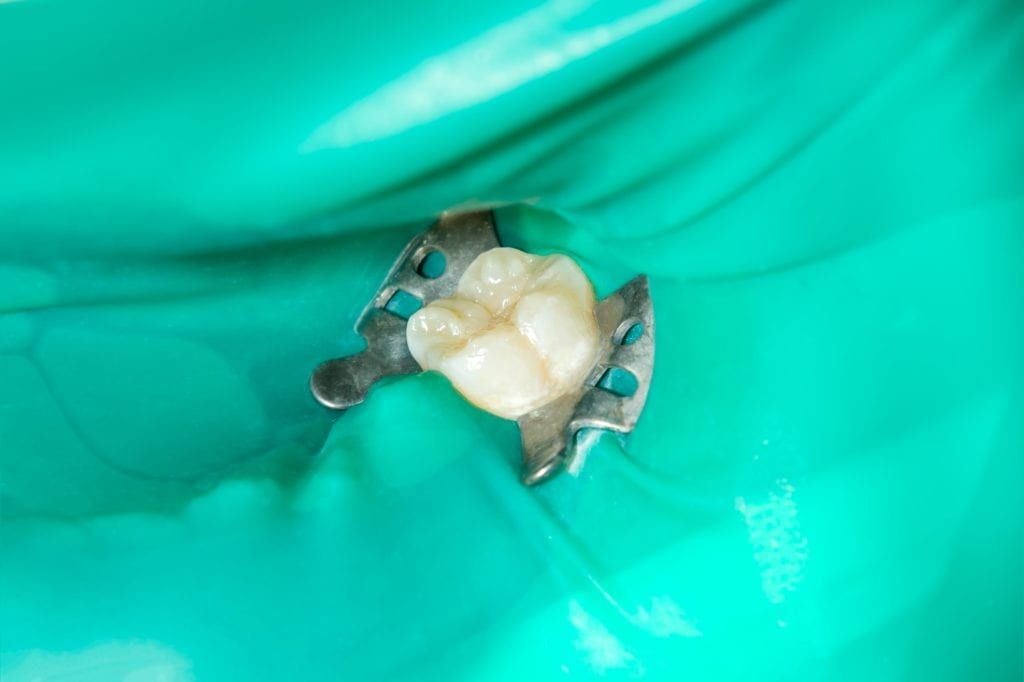
The most common direct restoration used by cosmetic dentists are composite fillings. Composite fillings are used to restore teeth with small to medium sized cavities caused by tooth decay. To place a composite filling, the decayed tissue must first be removed. Then, the composite resin will be applied to the cavity one layer at a time. Each layer will be hardened in place before placing the next layer. The final layer will then be shaped to blend in with the surrounding tooth structure before being hardened into place.
Composite resin can also be used for a restorative treatment known as cosmetic bonding. Cosmetic bonding, also known as dental bonding or composite bonding, uses composite resin to repair small chips or cracks in the teeth. Just like a composite filling, cosmetic bonding can be entirely completed in a single dental appointment.
An indirect restoration refers to permanent or semi-permanent fixed restorations that must be fabricated outside of the mouth. These types of restorations generally need to be fabricated by a dental laboratory, however they can also be fabricated using an in-office milling machine. Since they are fabricated using a dental lab, indirect restorations often require two dental appointments for proper placement.
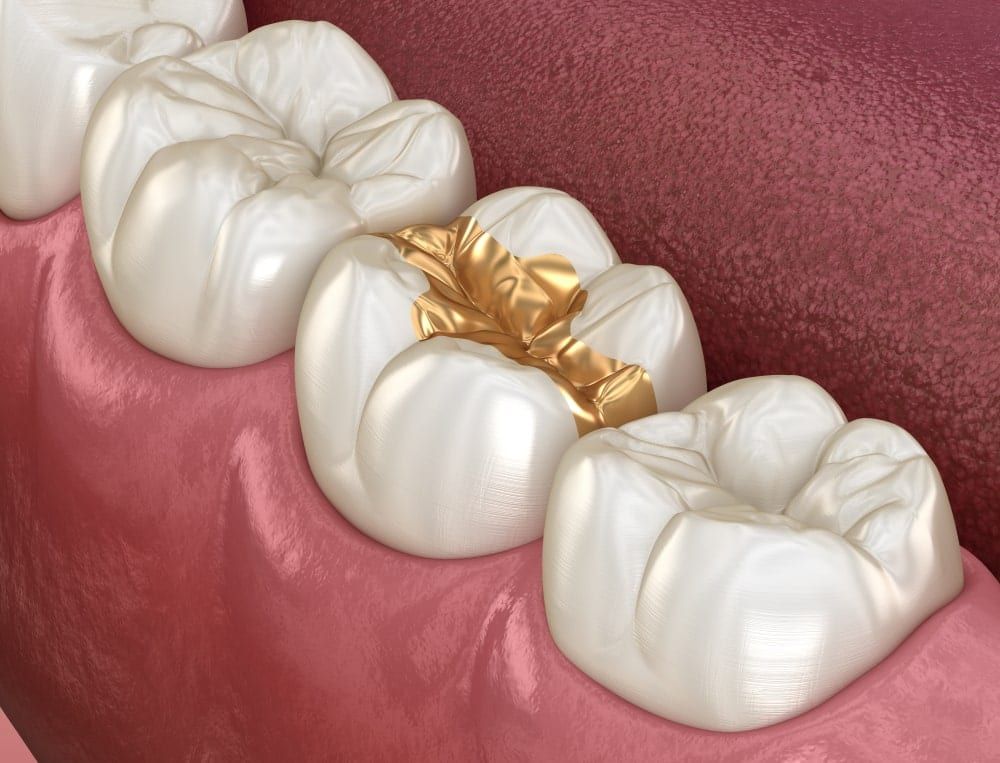
During the first appointment, the tooth is prepared by removing any decayed or damaged tissue and then shaping the remaining structure. Depending on the type of direct restoration being used, varying amounts of natural tooth structure may need to be removed or reshaped. Once the tooth is prepared, a dental impression or oral scan will be taken to obtain the information necessary for fabrication. This information is then sent to a dental laboratory and a temporary restoration will be placed to protect the tooth. Within a few weeks, a second appointment will be needed to check the fit of the restoration and permanently cement it in place.
Although indirect restorations take two appointments to place and require the use of a temporary restoration, they offer restoration options for larger areas of damage and decay. Furthermore, indirect restorations can be used to correct a number of cosmetic concerns, including discolored, oddly shaped, unevenly sized, or improperly spaced teeth. Examples of indirect restorations include:
Overall, these two different types of dental restorations offer a variety of options for restoring damaged or decayed teeth. Direct restorations are ideal for smaller areas of damage or decay, while indirect restorations can restore teeth with more severe damage or decay, as well as teeth with cosmetic concerns. When it comes to deciding which is better, you will need to visit your local cosmetic dentist’s office so they can advise you which restoration will work best for your individual needs.
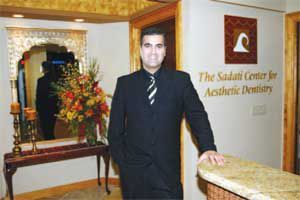
Dr. Sadati possesses extensive experience in all aspects of advanced restorative dentistry, with an emphasis in cosmetic and implant dentistry. He has attained Accredited Fellow status in the American Academy of Cosmetic Dentistry (AACD), the most rigorous, demanding credentialing process in the world. He is the only AACD Accredited Fellow in South Florida.
Habits are behaviors that we practice regularly, whether we are aware of it or not. We all have habits. Some of our habits are good and help us improve our overall well being. Others, unfortunately, are bad and can be detrimental to our overall well being. While there are a multitude of habits to consider, we are going to focus solely on habits that affect your oral health.
For starters, there are good oral habits that can help to maintain or improve your oral health. These include brushing twice a day for two minutes with a soft toothbrush, using fluoridated toothpaste, and flossing once a day. While these are the basic good oral habits, your dentist may also recommend additional habits to practice depending on your individual oral health needs.
Conversely, there are bad oral habits that can be detrimental to your oral health. For the sake of preventing your oral health from declining, we are going to focus on these habits in order to recommend what NOT to do. With that being said, here are some of the worst oral habits:
Contrary to popular belief, brushing your teeth really hard does not actually make them cleaner or brighter in color. Instead, brushing too hard can actually damage your tooth enamel and cause tooth sensitivity. Not only that, but you may also experience gum recession from brushing too hard. When brushing your teeth, you should use a soft toothbrush to gently massage your teeth using small circular motions.
Bruxism is the term used to describe the behavior of grinding or clenching your teeth together. Many people are unaware that they are bruxers until their dentist points it out. This is because the majority of teeth grinding and clenching occurs at night while you sleep. The force generated from bruxism can eventually lead to enamel erosion, chipped or cracked teeth, and jaw problems such as temporomandibular joint disorder (TMD). To prevent these things from happening, your dentist will prescribe a custom mouthguard to protect your teeth and alleviate the stress on your jaw joint.
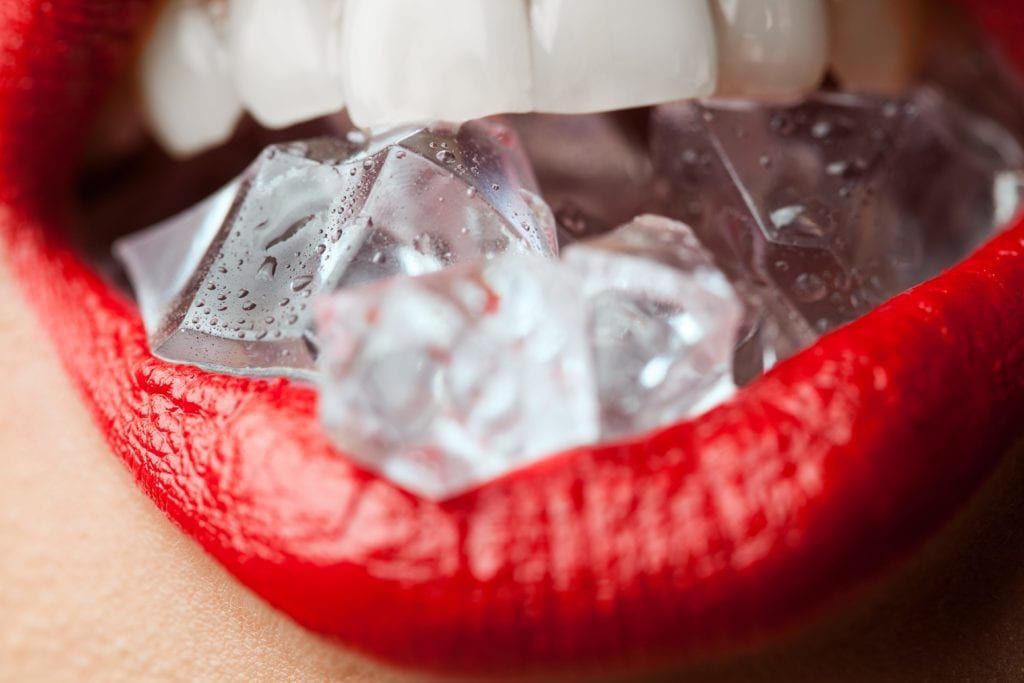
Chewing on ice is dangerous because both ice and enamel are crystalline structures at the molecular level. When two crystalline structures are grinded against each other, one will inevitably break. Although this is usually the ice, there are cases when the enamel may break instead. Additionally, ice chewing can dislodge fillings and be damaging to other dental restorations. If you find yourself craving ice, you may want to have your iron levels checked because this behavior is associated with an iron deficiency.
Nail biting is a common habit associated with anxiety. While many people immediately recognize the damage it does to their nails, not as many realize that it can also lead to chipped teeth. In addition to damaged teeth, nail biting can also lead to jaw dysfunction because it causes the jaw to maintain a protruded position for extended periods of time. If you are a nail biter, there are some options to help you stop biting your nails such as bitter-tasting nail polish.
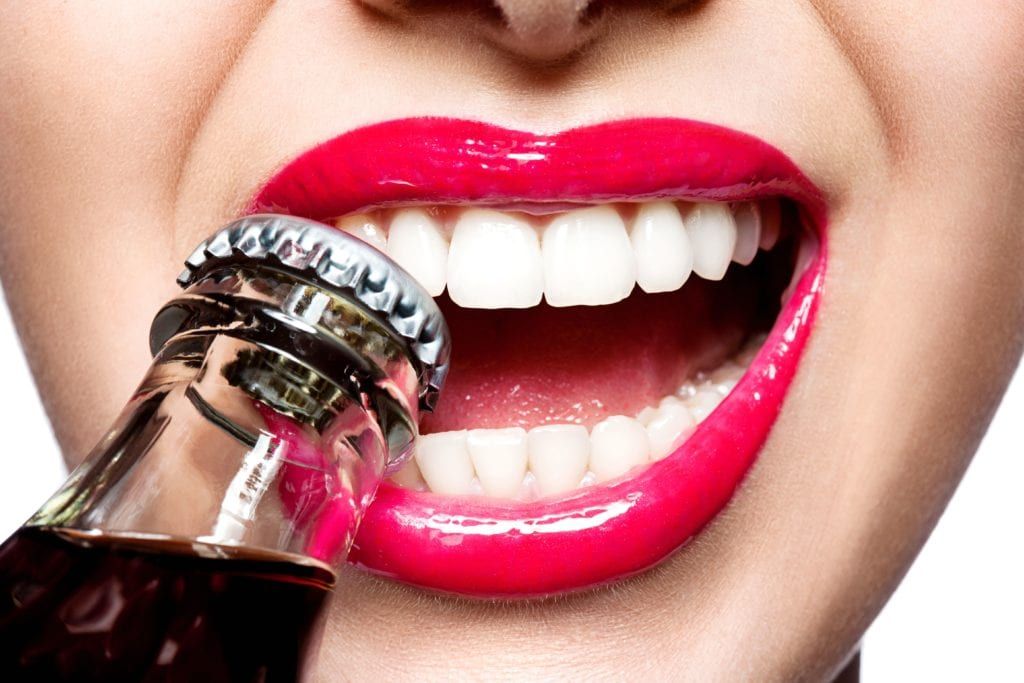
Your teeth are for biting and chewing food. Using your teeth for any other function can be potentially damaging. This means that behaviors such as using your teeth to hold, open, or cut things should be avoided to prevent your teeth from becoming chipped or cracked.
Overall, these are some of the worst oral habits that pose a threat to your oral health. These habits can unfortunately result in chipped or cracked teeth, damage to your enamel, and jaw dysfunction. Now that you are aware of these bad oral habits, it is important that you eliminate them in order to preserve your oral health.

Dr. Sadati possesses extensive experience in all aspects of advanced restorative dentistry, with an emphasis in cosmetic and implant dentistry. He has attained Accredited Fellow status in the American Academy of Cosmetic Dentistry (AACD), the most rigorous, demanding credentialing process in the world. He is the only AACD Accredited Fellow in South Florida.
Getting your teeth whitened is one of the easiest ways to makeover your smile. Additionally, professional teeth whitening is also highly affordable and yields excellent results. For these reasons, it is considered to be the most popular cosmetic dental treatment.
If you are considering having your teeth whitened by your local cosmetic dentist, you may be wondering how long your teeth will keep their bright appearance. This is a common concern among individuals who want to get their teeth whitened, but are afraid that it won’t last.
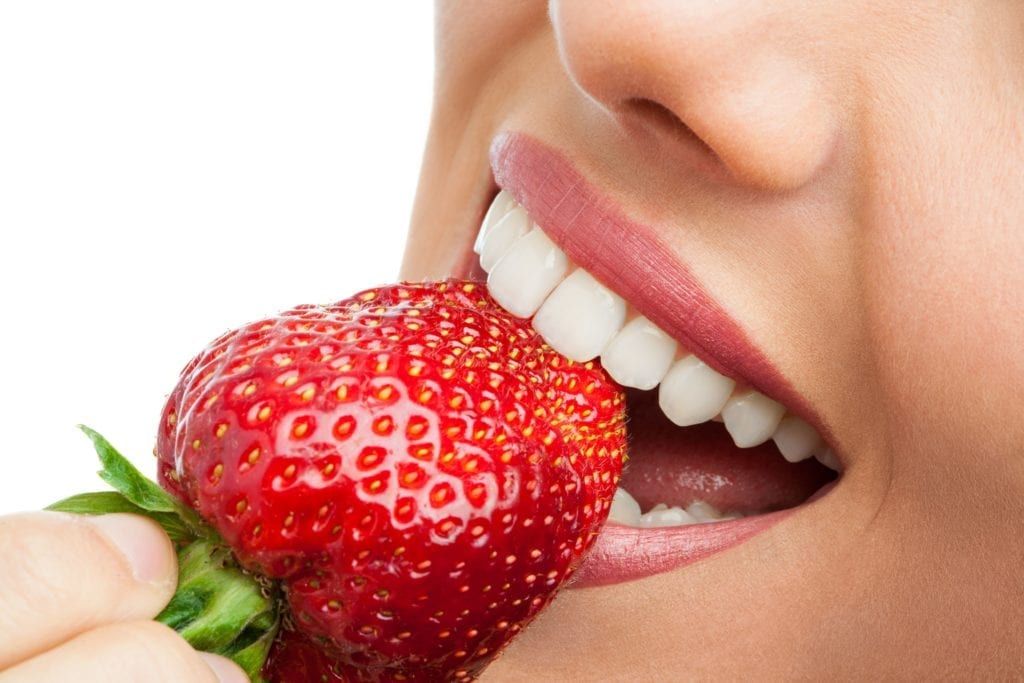
Unfortunately, there is no one answer to the question of how long teeth whitening results last. On average, results generally last a year, however there are cases where they may only last six months and other cases where they can last up to three years.
The primary reason for this large discrepancy is the simple fact that the lifespan of teeth whitening results is highly dependent on one’s individual habits, specifically what you eat, how well you clean your teeth, and whether or not you smoke. Other factors, such as age and certain medication, can also affect your results.
This is because professional teeth whitening is used to remove existing stains, but provides no protection against new stains. During a professional teeth whitening procedure, a whitener is applied to the surface of your teeth. This whitener is then absorbed into the enamel and dentin layers of the tooth where it initiates a chemical reaction that dissolves discolorations. While this is extremely effective in removing stains, the whitener is naturally absorbed by the body within 24 hours and is no longer effective at that time.
Just like any other cosmetic procedure, maintenance is very important. We recommend and provide all the materials and instructions for our patients who go through a professional whitening procedure to continue the home maintenance procedure once or twice monthly. With a proper home and professional hygiene care and and continuation of home whitening maintenance patients will keep their smile almost as white as the day after their initial professional whitening.
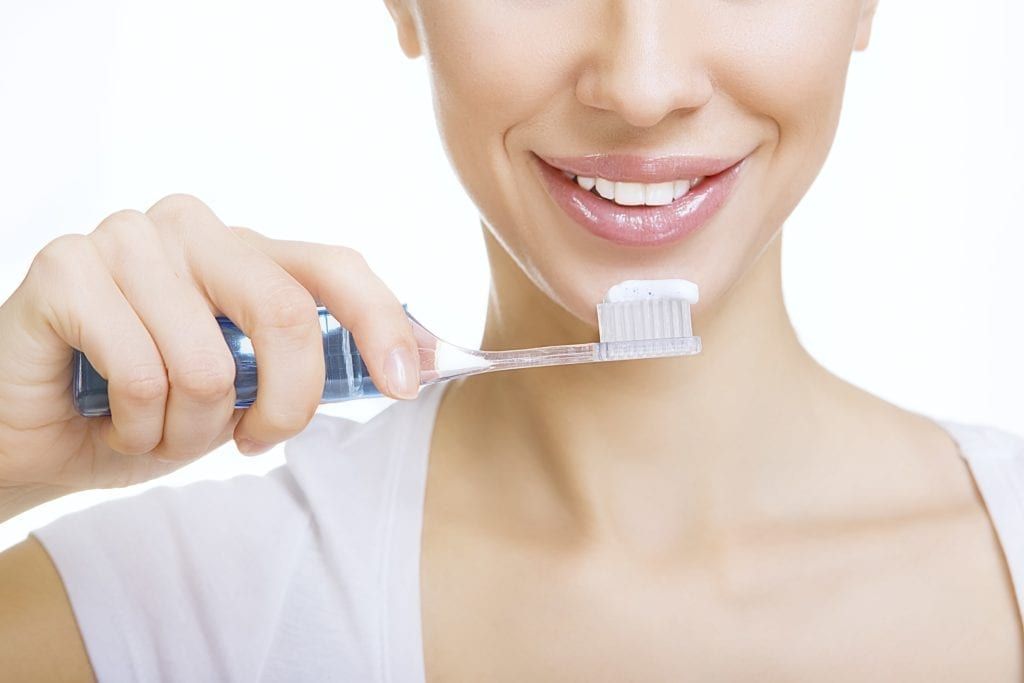
Additionally, the lifespan of your whitening results will depend upon the amount of stains you expose your teeth to after having your teeth whitened. Regularly exposing your teeth to new stains will cause them to discolor faster, whereas limiting stain exposure can prolong their bright appearance. This is why the lifespan of your whitening treatment depends primarily on your individual habits.
The first habit that affects the color of your teeth is what you eat and drink on a regular basis. Regularly consuming foods and beverages that are densely pigmented means that your teeth are more likely to stain faster. Another habit that affects your whitening results is your oral hygiene habits. If you brush right after consuming highly pigmented foods or beverages, you can decrease the amount of staining. Finally, the nicotine and tar found in cigarettes are almost guaranteed to stain your teeth, so if you smoke you can expect your results to fade faster.
At this point, you may be wondering if over the counter whitening treatments have a similar lifespan. The simple answer to this question is that the results of over the counter whitening treatments will be affected in the same way as professional teeth whitening. The main difference, however, is that professional teeth whitening uses a stronger whitener that produces more dramatic results in less time. This ultimately makes it seem like the results last longer since the results remove more stains instantly, rather than gradually lightening your teeth over time.
Overall, the results from professional teeth whitening can last anywhere from six months to three years. The main determining factor in how long your teeth remain white is your eating and oral hygiene habits, as well as whether or not you smoke. Additionally, even though over the counter whiteners have a similar lifespan, professional whitening services can produce more dramatic results that have the illusion of lasting longer.

Dr. Sadati possesses extensive experience in all aspects of advanced restorative dentistry, with an emphasis in cosmetic and implant dentistry. He has attained Accredited Fellow status in the American Academy of Cosmetic Dentistry (AACD), the most rigorous, demanding credentialing process in the world. He is the only AACD Accredited Fellow in South Florida.
Coronavirus or Covid-19, is caused by the SARS-CoV-2, a new strain of coronavirus that developed recently as a mutation of other coronaviruses. Unfortunately, this new strain has wreaked havoc in several countries around the world, including the United States. Currently, our federal government is urging people to remain in their homes to slow the spread of the virus. Some state and local governments have even gone as far as issuing mandatory shelter in place orders.
In coordination with federal guidelines, the American Dental Association has issued a formal statement recommending the temporary suspension of non-essential dental treatments until April 30th at the earliest. What this means is that dental offices across the country are remaining open only to tend to urgent or emergency dental cases.
With the temporary suspension of elective and preventative dental services, having a personal preventative dental routine is more important than ever before. Since the last thing you may be thinking about right now is your teeth, we’ve compiled a guide to managing your oral health during the Covid-19 crisis.
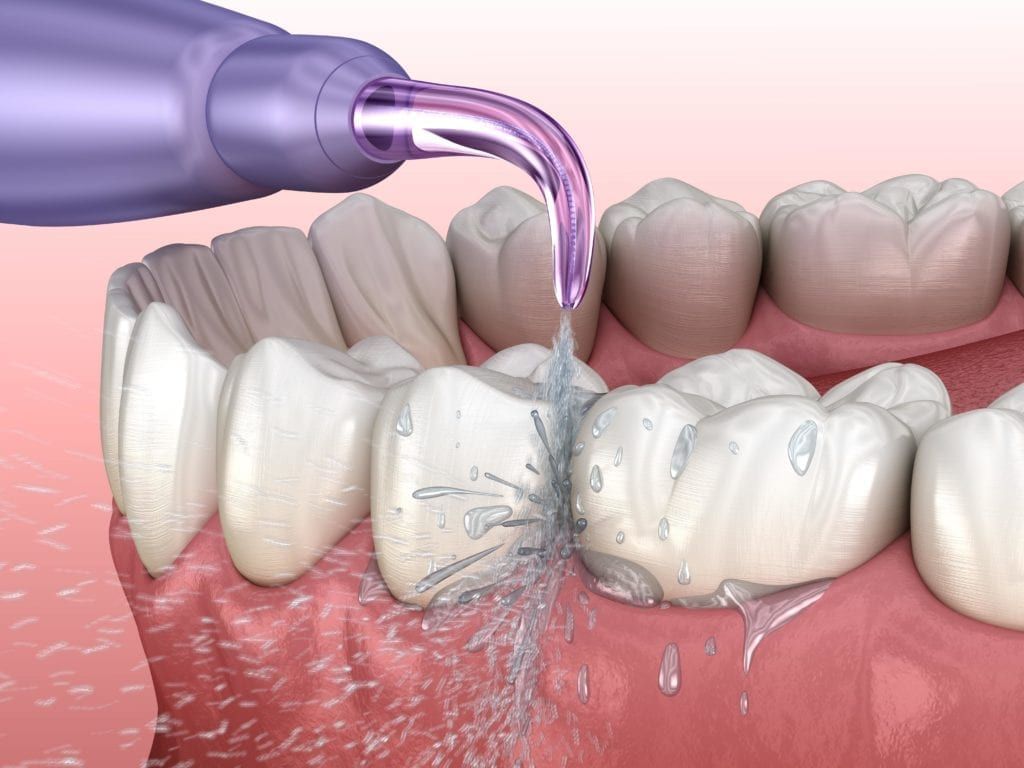
While there is a lot going on right now, it is important to maintain proper oral hygiene despite the fact that your daily routine may have changed. To maintain your oral hygiene, be sure to continue brushing twice a day with fluoridated toothpaste and a soft bristled toothbrush, and to floss daily. Both these activities will remove plaque and food debris from your teeth and reduce your risk of developing dental cavities.
If you have certain dental restorations, such as permanent bridgework, crowns, or dental implants, you will also need to continue cleaning your teeth using a waterpik. Waterpiks may also work better than flossing for people who have difficulty handling string floss or reaching the back of their mouth.
Another way to preserve your teeth is to manage the amount of sugar you consume. Sugars are found in most sweet treats, carbohydrates, and soft drinks, so you will want to limit the consumption of these items. This is because sugar feeds the decay-causing bacteria in your mouth and can result in tooth decay. When you do consume foods or beverages with excess sugar, rinse your mouth with water or milk afterwards to decrease the damage.
If your dentist has prescribed a mouthguard for TMD or bruxism, be sure to wear it as directed. This will keep your jaw in the proper position and reduce the symptoms associated with TMD. Additionally, mouthguards protect your teeth from becoming chipped or cracked as a result of the pressure exerted by bruxism.

While it is a good idea to generally limit your consumption of foods that are very hard, chewy, sticky, or crunchy, now would be a good time to avoid them altogether. This is because these foods can potentially cause damage to your teeth and dislodge dental restorations. Therefore, to prevent the need for an emergency dental visit, we recommend temporarily abstaining from consuming these foods.
In addition to avoiding foods that can damage your teeth, it is also recommended to avoid behaviors that can cause damage as well. Some examples include: nail biting, ice chewing, and using your teeth to open bottles and packages. Basically, you should avoid using your teeth for anything but biting and chewing food.
Overall, everyone here at The Sadati Center for Aesthetic Dentistry hopes that this guide will help you to preserve your oral health during the covid-19 outbreak. By maintaining proper oral hygiene, managing your sugar levels, wearing your mouthguard, and avoiding certain foods and behaviors, you have the best chance of keeping your teeth in good condition and avoiding potential dental emergencies. In the case that you do have a dental emergency, call our office for further information.

Dr. Sadati possesses extensive experience in all aspects of advanced restorative dentistry, with an emphasis in cosmetic and implant dentistry. He has attained Accredited Fellow status in the American Academy of Cosmetic Dentistry (AACD), the most rigorous, demanding credentialing process in the world. He is the only AACD Accredited Fellow in South Florida.
Dental anxiety is a common reason for people to avoid dental checkups. Dental phobias, however, can have a severe impact on your smile, and avoiding the dentist can leave for dental diseases such as gum disease, tooth decay, and crooked teeth. With dental anxiety, it can make it challenging to schedule appointments, notice dental problems ahead of time, and overcome those fears. When it comes to coping with dental anxiety, the best form of treating it is to find a dental office, you can trust. Here are some of the critical aspects of any trustworthy dental office that you should look for:
1. They’ll have professional association memberships
Dentists that are members of the ADA, or the American Dental Association, will abide by the codes and conditions of that membership, which include proper dental ethics, professional conduct, and dentistry guidelines. Dentists that show these associations on their website will be more trustworthy, which can ease your dental anxiety.
2. They’ll have safe, effective, dental technology
Dental technology is a continually changing industry, as many manufacturers are consistently developing new ways of handling dental anxiety through safer, more convenient means. A right dentist will explain to you their dental process and the tool they use to help clear up any fears you may have about your appointment.
3. They’ll have an inviting office environment
Professional dentists should focus on décor, color schemes, and amenities to help ease and soothe their patients. Depending on the brand image, choosing colors that soothe, invigorate, and relax their patients, such as blue, green, and orange, can help distract those worries and anxieties. Also, their staff members will pay attention to temperature changes, scents, and will help use comfort items such as soft pillows, to aid in the atmosphere.
4. They’ll focus on transparency
Any right dentist will try to focus on transparency, meaning they’ll explain their process, inform you about their insurance and payment methods, and will accurately inform you about any risks associated with their dental procedures. For patients dealing with dental anxiety, the best way to combat anxiety is to remove any assumptions made.
5. They’ll guide you through every step
In cases where you experience an anxiety attack, your dentist can aid using mindfulness techniques, such as breathing exercises, signals, and other distractions, to help guide you through the procedure. The right dentist should effectively communicate with you, and by doing the same, your dental anxiety can lessen.
When it comes to dental anxiety, Dr. Sam S. Sadati follows all of these guidelines. At the Sadati Center for Aesthetic Dentistry, Dr. Sadati takes the time to care for his patients and brings a welcoming, friendly environment that’s safe and appreciative of both new and current patients. Located in Wellington, FL, Dr. Sadati focuses on creating a beautiful, relaxing environment for his aesthetic dentistry services, and has a keen experience working with patients who have dental anxiety. If interested, contact Dr. Sadati today to schedule an appointment.
Aging is part of the human experience and it’s something that we will all do eventually. Despite this, we strive to hold onto our youthful appearance for as long as possible. There is no shortage of anti-aging products and treatments available today to slow the effects of aging. While many people tend to focus on decreasing the prevalence of wrinkles, did you know that your smile is another important indicator of age?

As we age, our smile can change in various ways. For starters, our teeth may be worn down, damaged, or uneven due to years of wear and tear. This is further compounded if you grind or clench your teeth. Our teeth also are likely to appear more yellowish as a result of the dentin layer showing through as the enamel becomes thinner.
Depending on your oral health, you may also notice undesirable changes in your gums, such as redness, swelling, or bleeding caused by gum disease. Some people can also have loose teeth or teeth that are missing altogether. In cases where missing teeth are not replaced soon enough, the face can even change shape as a result of lost bone mass.
Just as these changes can make you appear older, restoring your smile can make you appear younger. Let’s take a look at some of the ways that cosmetic dentistry makes you look younger:
Gum recession is when the gums pull away from your teeth, creating deep pockets that make your teeth look very large. This is a common symptom of gum disease, but can also be caused by things like brushing too hard. Gum recession is also a common phenomenon associated with aging since people over 60 are especially prone to gum disease. For severe cases of gum recession, your cosmetic dentist is likely to recommend a gum graft to promote healthy tissue growth. Not only will this improve the condition of your gums, but it will improve the contour of your gum line and the size of your teeth.
After a lifetime of eating and drinking a variety of foods and beverages, you can expect your teeth to not be as bright as they once were. Combine this with the natural yellowing that happens with enamel thinning, and your teeth may appear quite dingy. Cosmetic dental treatments such as crowns or veneers are two popular ways to conceal stained teeth and give you a whiter smile. Teeth whitening may also be able to be used, however it may not always be effective for certain types of stains, therefore your cosmetic dentist can help you decide which treatment would work best for you. Brightening the color of your smile is one easy way to make your smile appear more youthful and vibrant.

As you age, it is not uncommon for your teeth to appear worn down or oddly shaped due to uneven wear. In some cases, you may even have minor chips and cracks. Whatever the extent of damage is, cosmetic dental treatments such as crowns, cosmetic bonding, and veneers can be used to eliminate the damage. This gives your teeth a fresh and lively look. Even cases with one or more missing teeth can be remedied by a dental bridge.
If, however, you do have one or more missing teeth, the best option is to have dental implants placed. Dental implants provide enough stimulation to the jawbone to maintain the proper amount of bone mass. Without adequate stimulation, the jawbone will deteriorate when one or more teeth are missing. Eventually, this causes a change in facial structure and can make you look years older than you actually are. Having dental implants placed not only replaces missing teeth, but it also preserves your youthful facial structure.
Overall, cosmetic dentistry can make you look younger by targeting the changes in our smile associated with aging. In addressing these changes, your cosmetic dentist can reduce the look of aging by designing your smile to have a more youthful appearance. Not only that, but cosmetic dentistry can also improve your oral health and improve the function of your teeth. If you are considering cosmetic dentistry, don’t wait any longer. After all, you’re not getting any younger.

Dr. Sadati possesses extensive experience in all aspects of advanced restorative dentistry, with an emphasis in cosmetic and implant dentistry. He has attained Accredited Fellow status in the American Academy of Cosmetic Dentistry (AACD), the most rigorous, demanding credentialing process in the world. He is the only AACD Accredited Fellow in South Florida.
Did you know that your gums are just as important for the overall look of your smile as your teeth are? While many people place great importance on making sure their teeth are white, bright, and properly aligned, not everyone realizes that their gums can help to make or break a beautiful smile. Additionally some people may even be surprised when their cosmetic dentist suggests gum modifications in addition to other cosmetic dental treatments.
This is because your cosmetic dentist is an expert in visual smile aesthetics. Their extensive experience allows them to see beyond simply the teeth so they can improve everything about your smile. Therefore when evaluating a smile, your dentist can classify smiles as either having a low smile line or a gingival smile line.

Many cosmetic dentists consider low smile lines to be the optimal smile line. A low smile line is when your upper lip naturally conceals your upper gums, meaning that only your teeth are visible. A gingival smile line, on the other hand, refers to a smile where the upper gum tissue is visible to some extent. The amount of visible gum tissue can vary, but cosmetic dentists consider less visible gum tissue as being ideal.
At this point, you may be wondering why some people have low smile lines and others have gingival smile lines. The simple answer is that everyone is different. The type of smile you have is based on many different factors, including:
While all these factors can affect the look of your smile, there are a few possible things that can cause gingival smile lines. One possible cause is an abnormal eruption of teeth that causes excess gum tissue to remain. For this reason, people who have gingival smile lines are also said to have gummy smiles, a high lip line, short upper lip, and full denture smiles. This type of smile can also be caused by improper development of the upper jaw, as well as a hyperactive lip muscle.

Cases of gummy smiles that are not the result of potentially damaging dental conditions or that are mainly cosmetic may not require treatment. However, depending on the cause of the high smile line, certain action may be recommended. For example, if a high smile line is the result of improper upper jaw development, then orthodontic treatment may be recommended to prevent future bite problems.
Despite the fact that not all gummy smiles may require treatment, there are some individuals who elect for cosmetic dental treatments aimed at improving the appearance of their gums. A gingivectomy is a popular procedure used to remove and reshape excess gum tissue to improve the tooth to gum ratio, as well as the contour of the gums. Most cosmetic dentists can easily perform this procedure in-office with a dental laser.
Overall, gingival smile lines are present when the gums are visible while smiling. Since both your teeth and your gums play an integral role in creating the look of your smile, some people may not be satisfied with the look of gingival smile lines. Depending on the severity, cause, and personal preference regarding a high line smile, there are treatments that can be used. For more information, schedule a consultation with your Wellington cosmetic dentist today.

Dr. Sadati possesses extensive experience in all aspects of advanced restorative dentistry, with an emphasis in cosmetic and implant dentistry. He has attained Accredited Fellow status in the American Academy of Cosmetic Dentistry (AACD), the most rigorous, demanding credentialing process in the world. He is the only AACD Accredited Fellow in South Florida.
You are likely familiar with, or at least have heard the terms tooth decay and gum disease. But, are you familiar with dental erosion? While tooth decay and gum disease are the most common oral health concerns, dental erosion is another thing to be concerned about.
In order to understand what dental erosion is, we must first look into the basic tooth structure. Your tooth is composed of three layers: the outer enamel, the middle dentin, and the inner dental pulp. Of these three layers, the enamel layer is by far the strongest layer and is used to protect the two underlying layers. In fact, tooth enamel is actually the strongest substance in the human body.
This is because of its molecular composition. Tooth enamel is made up of hydroxyapatite, which is the scientific term for calcium phosphate. Furthermore, both the calcium and phosphorus molecules contained in hydroxyapatite are arranged in a crystallized pattern, which further adds to enamel’s strength.
However, because tooth enamel is composed primarily of minerals, this also means that it can demineralize. The most common cause of enamel demineralization is acidic waste products produced by bacteria in the mouth. This is more commonly known simply as tooth decay.
Unfortunately, this is not the only thing that causes enamel to be lost. When tooth enamel is lost for reasons other than bacteria, this is known as dental erosion. Tooth sensitivity, discoloration, indentations on the teeth, and teeth that damage easily are all potential symptoms of dental erosion. However, dental erosion does not always cause symptoms, especially in the early stages. Dental erosion can be the result of various things, such as:

What you eat and drink on a daily basis affects your overall oral health, as well as the condition of your enamel. Sugary and starchy foods can cause tooth decay by feeding bacteria, while acidic foods and beverages can cause enamel erosion due to their acid concentration. Citrus fruits and juices, apples, rhubarb, and sodas with citric or phosphoric acid can all potentially damage the enamel if consumed in excess amounts.
Saliva plays many important roles in the mouth. One role is to manage the amount of acid content so that the concentration does not get too high. However, when there is a lack of saliva due to medical conditions or certain medications, the acid concentration in the mouth can increase. This means that people with dry mouth are more likely to have their enamel eroded as the result of excess acid content in the mouth.
Teeth grinding or clenching can also be responsible for the erosion of enamel. Both behaviors place additional strain on the tooth enamel that will eventually cause it to break down. As the enamel breaks down, the teeth may even change in shape and color since the enamel will thin and expose the underlying dentin layer.

Stomach acid is an important part of our digestive system, however it can cause numerous problems when it does not remain within the stomach. Acid reflux disorders or medical conditions that cause frequent vomiting can both increase the amount of acid in the mouth. The constant exposure to this acid unfortunately erodes the enamel.
As you can see, dental erosion is something that you should be concerned about. Although it may not be as common as tooth decay and gum disease, it is still a relatively common oral health concern that can negatively impact the condition and function of your teeth. Dental erosion is most commonly caused by dry mouth, stomach acid, diet, and bruxism, so you will want to discuss these things with your dentist to reduce your risk of developing severe dental erosion.

Dr. Sadati possesses extensive experience in all aspects of advanced restorative dentistry, with an emphasis in cosmetic and implant dentistry. He has attained Accredited Fellow status in the American Academy of Cosmetic Dentistry (AACD), the most rigorous, demanding credentialing process in the world. He is the only AACD Accredited Fellow in South Florida.
Did you know that spending more time in that beautiful Florida sun can help your dental implant heal? No, the Florida sun is not magical. Rather, it is simple science. Sunlight is one of the primary sources of vitamin D and vitamin D can help dental implants heal. So, how is this possible?
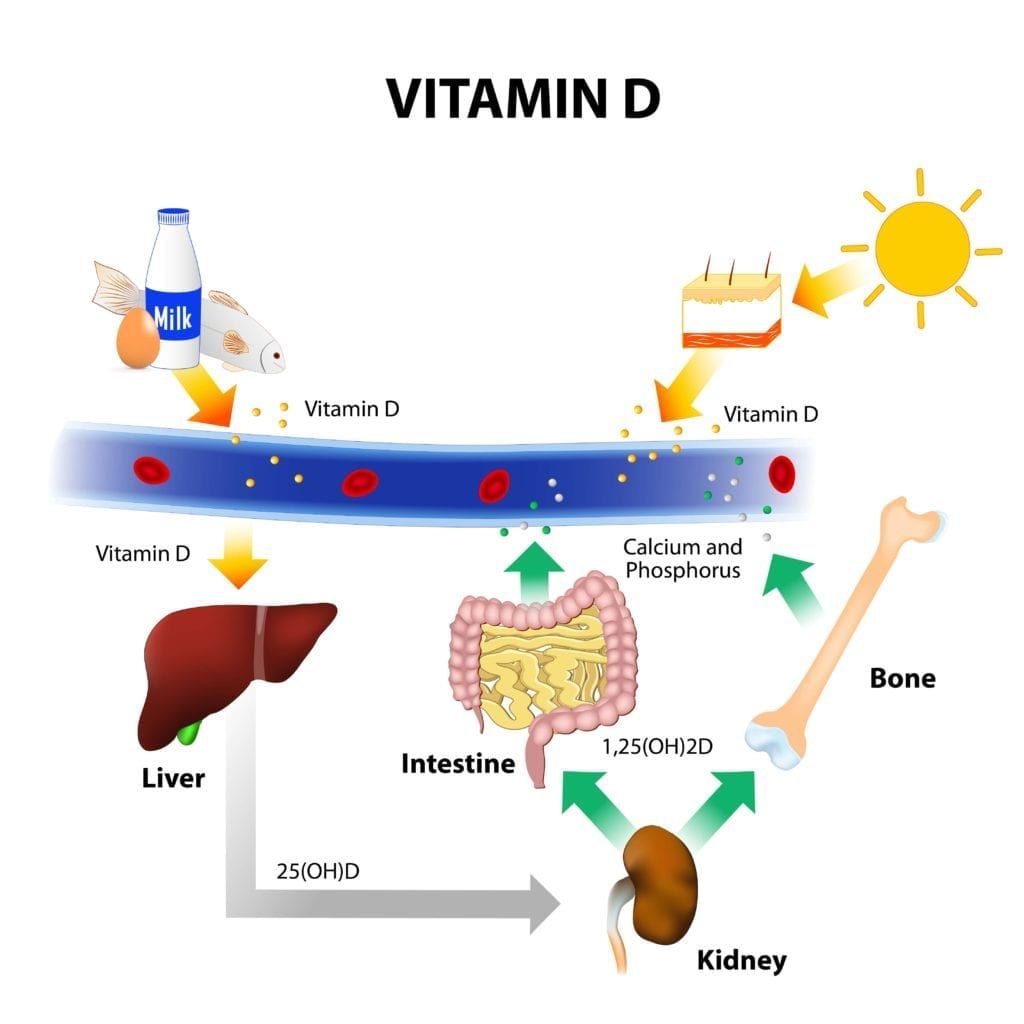
Well, vitamin D is used by the body to absorb calcium and phosphorus from foods passing through the large intestine. In fact, the body cannot absorb calcium if vitamin D is not present. Since calcium and phosphorus are essential for new bone growth and maintain health bones, they are important during the implant recovery process. Because they can only be absorbed with vitamin D, this makes vitamin D equally as important.
After you have dental implants placed, they must undergo a process called osseointegration in order to be successful. Osseointegration is the process of new bone growth around the implant that fuses the implant securely within the surrounding bone. This fusion is what gives dental implants their strength. People who have adequate amounts of vitamin D are more likely to have proper bone growth, while those who are deficient may lack proper bone growth or take longer to grow new bone. Ultimately, vitamin D helps dental implants to heal faster and increases the chances of treatment success.
Not only that, but vitamin D also has antimicrobial and anti-inflammatory properties. Because of this, the risk of postoperative infection is reduced, as well as the risk of gum disease. Healthy gums are important when having dental implants placed because they help to support the implant and prosthesis.
At this point, you may be wondering how to know if you have a vitamin D deficiency and how to correct this. A study posted on the National Center for Biotechnology Information database found that as many as 41.6% Americans have a vitamin D deficiency, making it extremely common. Furthermore, you are at an elevated risk if you:

Additionally, there are certain signs that can indicate a possible deficiency, such as: bone or hair loss, muscle or bone pain, fatigue, depression, wounds that don’t heal, or being sick a lot. While the risk factors and signs may indicate a vitamin D deficiency, ultimately the only way to know if you are deficient is to visit your primary care physician. They will likely order a blood test to check your level of vitamin D and determine supplements or lifestyle changes are needed.
If you are found to be deficient in vitamin D, your doctor may advise you to spend more time in the sun, eat more fatty fish and dairy, or start taking a vitamin D supplement. In most cases, it is recommended that you get 600 IU of vitamin D a day, or 800 IU if you are over the age of 70.
Overall, having adequate amounts of vitamin D is an easy way to help improve your dental implant treatment outcomes. Not only does it promote bone growth to expedite healing, but it also helps to reduce complications like infection and gum disease. Conversely, a vitamin D deficiency can slow down healing or result in inadequate bone growth. If you are having dental implants placed soon, you may want to consider spending more time in that beautiful Florida sun.

Dr. Sadati possesses extensive experience in all aspects of advanced restorative dentistry, with an emphasis in cosmetic and implant dentistry. He has attained Accredited Fellow status in the American Academy of Cosmetic Dentistry (AACD), the most rigorous, demanding credentialing process in the world. He is the only AACD Accredited Fellow in South Florida.
Over 90% of all Americans have some type of tooth decay.
While most of us brush our teeth at least twice a day, sometimes that isn’t enough to keep our teeth healthy. That’s why professional teeth cleanings are so important.
But they can also be stress-inducing if you don’t know what to expect.
We’ve put together this guide to answer common teeth cleaning questions and walk you through what happens from the moment you sit in the dental chair to the moment you stand back up again.
So let’s get started!
You already brush and floss your teeth at home every day. Do you really need to get professional cleanings?
The short answer to this question is yes, and here’s why.
Your dental hygienist can clean the “hard spots” in your mouth that you have trouble reaching yourself. They also have the tools and experience that allow them to clean your teeth better than you can.
But more importantly, your dental hygienist can spot and address any signs of more serious conditions during the cleaning. This reduces your risk of developing gum disease and other related health problems later.
Because of this, you should schedule at least one teeth cleaning a year, but depending on your oral health, you may benefit from a cleaning every six months.
Your dental cleaning will take about 30 minutes to an hour, and during this time, your hygienist will go through several different steps.
It all starts with a basic examination. This is the part where your dental hygienist will check for any signs of tooth decay, gum gingivitis, or other oral health issues. They’ll also look for areas with plaque or tartar that will need extra attention during the cleaning.
If they do find a potential problem during the examination, your hygienist will make a note of it, and they may talk to the dentist to ensure it’s still safe to move forward with the cleaning.
Plaque is a bacterial film that covers the surface of your teeth after you eat. It’s what gives your teeth that textured or bumpy feeling. You can remove plaque on your own by giving your teeth a good brushing.
However, if you leave plaque alone for too long (about 48 hours), it will harder into tartar. Once this happens, you can’t get rid of it by yourself.
That’s why it’s so important to get a professional cleaning.
Your dental hygienist will use a tool called a scaler to scrape any plaque or tartar buildup off your teeth. You’ll hear a scraping sound, and you might feel pressure on your teeth, but the process shouldn’t hurt.
The hygienist might have to spend several minutes on this step. If you have a lot of plaque or tartar, this might be the longest part of your cleaning.
Once they finish removing any plaque or tartar, your hygienist will brush your teeth with an electric toothbrush.
The toothpaste they use might taste the same as normal toothpaste, but it will fill grittier. This rougher consistency will help scrub and polish your teeth.
But you should never use this type of toothpaste at home.
Since it has a rougher consistency, this toothpaste can damage your enamel if you use it too often. While this toothpaste won’t damage your teeth during a professional cleaning, it’s not something you should use on a daily basis.
Your dental hygienist will also spend some time flossing your teeth.
Even if you floss regularly at home, you might experience a small amount of gum bleeding during this step. This is because your hygienist can reach all the nooks and crannies you might not be able to get yourself.
Flossing will also help your hygienist remove any last debris they may have missed earlier.
Now your dental hygienist will give you a chance to rinse out your mouth. They may give you normal water to do this, or they may give you water that contains liquid fluoride.
Fluoride is a natural mineral that strengthens your tooth enamel. To finish the cleaning, your hygienist will coat your teeth in a gel or paste that contains fluoride and leave it there for at least one minute.
And if you’re worried about fluoride poisoning, don’t be. Fluoride is completely safe. In fact, fluoride is added to drinking water, and it benefits your oral and bone health.
It depends on the person.
In most cases, you shouldn’t experience any pain during a professional teeth cleaning. That said, you might feel a small amount of discomfort during some of the steps, such as the flossing.
If you have sensitive gums or are worried about pain, make sure you talk to your dental hygienist before the cleaning. They may be able to administer a topical anesthetic before the treatment.
And talk to your hygienist during the cleaning. If something feels uncomfortable, let them know. They’ll do everything they can to keep you as comfortable as they can.
If you haven’t had a professional teeth cleaning in more than a year, you should schedule one as soon as possible.
Not sure who to contact? We can help! We provide quality dental cleaning services in the Wellington, Florida area.
You can schedule an appointment with us by calling 888-873-3558, or if you’re already a patient with us, click here to get in touch with us today!
Over the years, cosmetic dentistry has developed several treatments to improve the look of your smile by altering the size, shape, color, alignment, and spacing of your teeth. In fact, the vast majority of cosmetic dental treatments focus solely on improving the appearance of the teeth. However, there is one cosmetic dental procedure that actually improves the aesthetics of your smile by focusing on your gums instead of your teeth.
A gingivectomy, more commonly known as a gum lift or gum contouring surgery, is a cosmetic dental procedure that removes and/or reshapes gingival tissue so that it properly supports and surrounds the tooth. Gum lifts can be performed as an individual procedure, or they may also be used in combination with other cosmetic procedures to obtain the desired treatment results. In fact, certain treatments like dental crowns or veneers will actually look better after having a cosmetic gum lift. In order to obtain the best results, however, it is highly important to pick a skilled cosmetic dentist who has extensive experience performing periodontal procedures.
Some common reasons people opt to have a gingivectomy include:
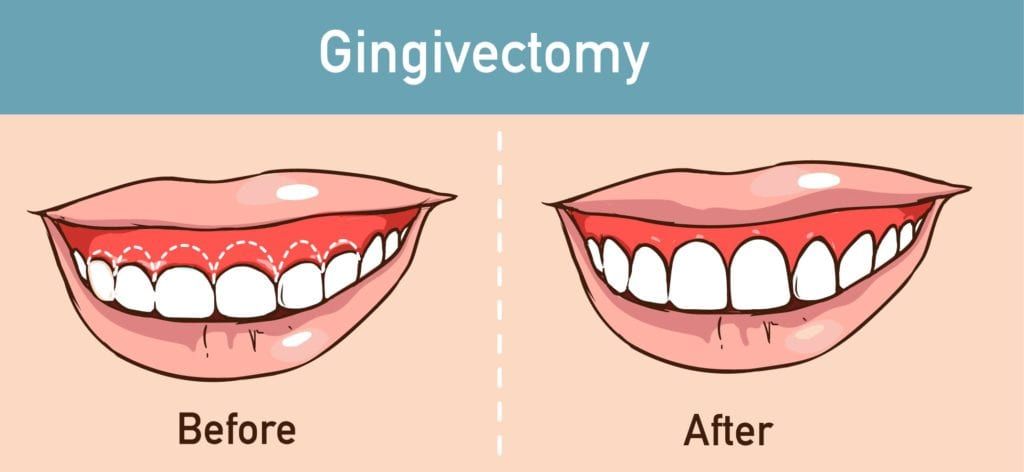
When the gums sit too low on the teeth, they can make normal-sized teeth appear small. Additionally, they can increase the risk of tooth decay and gum disease because bacteria are more likely to get trapped under the excess gum tissue. People with low gum tissue are commonly referred to as having “gummy smiles”. Gummy smiles are usually caused by genetics, certain health conditions, or some types of prescription drugs.

When the gums sit too high on the teeth, they can make normal-sized teeth appear large. Additionally, they are an indicator of gum disease, and can also cause tooth sensitivity and decay. Gum recession is the technical term for when the gums sit too high on the teeth, and it can be caused by gum disease, improper brushing or flossing technique, teeth grinding and clenching, and a variety of those things.
In certain cases, there may be instances where the gum tissue is simply uneven. This may mean some teeth are affected by gum recession, while others are affected by gummy smiles, and so on and so forth. In short, this just means the gum disease simply needs to be adjusted so that it is consistent.
When having a cosmetic gum lift, you will be given local anesthetics to keep you numb. You may also be offered varying levels of dental sedation to keep you calm during the procedure. Once you are comfortable, your cosmetic dentist will use a dental laser to remove excess gum tissue, as well as to reshape the remaining tissue. Dental lasers cauterize the blood vessels at the same time they remove or reshape tissue, meaning there is no bleeding or need for stitches.
Although dental lasers have greatly improved the cosmetic gum lift procedure, there is still a brief recovery period. Your cosmetic dentist will provide you with post-operative guidelines to follow after your gum lift. In most cases, these guidelines will recommend eating soft foods, keeping the treatment area clean, and using certain pain medications.
Overall, cosmetic gum procedures are intended to remove and reshape gingival tissue to improve the aesthetics of your smile. They can be performed alone or in combination with other treatments, however using an experienced cosmetic dentist is the key to obtaining great results. If you believe your gums are hindering the appearance of your smile, then a gum lift may just be the perfect cosmetic dental treatment for you.

Dr. Sadati possesses extensive experience in all aspects of advanced restorative dentistry, with an emphasis in cosmetic and implant dentistry. He has attained Accredited Fellow status in the American Academy of Cosmetic Dentistry (AACD), the most rigorous, demanding credentialing process in the world. He is the only AACD Accredited Fellow in South Florida.
Having a bright, white smile is one of the fastest and easiest ways to lighten up your entire face and make you appear younger. Not only that, but having a beautiful smile is infectious and will help you radiate positivity and warmth. However, keeping your teeth white can sometimes feel like an uphill battle.
For starters our teeth are porous, meaning that they absorb colored pigments from anything we eat or drink. Over time, this will inevitably cause them to become discolored and even permanently stained. Certain medications can also cause our teeth to stain from the inside out. Not only that, but our teeth will naturally yellow with age as our enamel thins and exposes more of the underlying dentin which is yellowish in color.
With so many factors stacked against us, how do we obtain that bright, white smile we’ve always dreamed of? Luckily, cosmetic dentists have a few tricks up their sleeve to help improve the appearance of stained teeth:
Professional teeth whitening, also sometimes referred to as teeth bleaching, is usually one of the first cosmetic treatments people use to whiten their teeth. It is a quick and non-invasive procedure in which a whitener is brushed onto the surface of the teeth and left in place for up to an hour. The whitener is then absorbed by the enamel and dentin layers of the tooth, where it triggers a chemical reaction that dissolves colored pigments. The end result is a whiter smile. However, teeth whitening procedures may not be effective on certain types of stains such as those from medications or aging.

Dental veneers, often referred to as porcelain veneers, are thin shells of porcelain that are adhered to the front surface of visible teeth. Each veneer is fabricated in a dental lab and is customized in terms of color. Although composite resin can be used for veneers, porcelain is generally recommended because it is stain-resistant. Therefore, multiple veneers can be used to create a whiter smile or even a single veneer can be used to cover a single discolored tooth. Veneers are ideal for individuals that have had limited or no results from teeth whitening procedures due to intrinsic staining. Unlike teeth whitening, however, veneers do not actually change the color of the teeth, rather they simply cover up the discolorations.
Dental crowns, sometimes referred to as caps, fit over the entire visible portion of the tooth. They are commonly used to restore teeth that are severely decayed or damaged, but they can also be used to improve the color of stained teeth. Like veneers, they do not change the actual color of the teeth. Unlike veneers, however, they cover the entire tooth surface rather than just the front. Additionally, crowns can be used in the back of the mouth, while veneers are generally only recommended for use towards the front of the mouth.
As you can see, there are few different options available when it comes to whitening stained teeth. Professional teeth whitening procedures work well for those looking for a fast and easy whitening method, while veneers and crowns are ideal for those who have stubborn stains or discolorations that cannot be helped by teeth whitening procedures alone. Ultimately, if you want to have your teeth whitened, it is recommended to consult with a cosmetic dentist to determine which method is best for you.

Dr. Sadati possesses extensive experience in all aspects of advanced restorative dentistry, with an emphasis in cosmetic and implant dentistry. He has attained Accredited Fellow status in the American Academy of Cosmetic Dentistry (AACD), the most rigorous, demanding credentialing process in the world. He is the only AACD Accredited Fellow in South Florida.
Experience for yourself how good it feels to have a brilliant, healthy smile! Feeling good about your smile, and each moment you spend with us, is our determination at Dr. Sadati’s South Florida dental office.
We consider each person we meet as much more than just a patient. Guests of The Sadati Center for Aesthetic Dentistry are treated as such! As our guest, you will receive special attention, a menu of comfortable amenities, and the friendly treatment you deserve.
If you’ve never felt the personal care and warmth of a dentist who wants the best for you, we invite you to get to know Dr. Sadati. Dr. Sadati understands that receiving high quality cosmetic techniques, today’s beautiful materials and long-lasting health are important to you. However, just as important to Dr. Sadati is that you feel comfortable and enjoy an open and honest environment, where your needs come first.
Countless hours of hands-on coursework and more than fifteen years of experience allow Dr. Sadati to enhance your smile with artistry, conservation, and craftsmanship.
Schedule a consultation to learn more about your options today.
As one of only a few dentists worldwide who have earned a Fellow accreditation with the American Academy of Cosmetic Dentistry (AACD), Dr. Sadati is qualified to help you achieve great things for your oral health!
We begin with the foundation of healthy gums, teeth and joints through our comprehensive hygiene program and examinations. From there, the possibilities are developed into your own personal treatment plan to help:
Achieving your goals may include some of the latest cosmetic dentistry techniques like teeth whitening, laser dentistry, sedation, metal-free fillings, implants, veneers, crowns & bonding.
We encourage you to take a closer look at many of these options, and to talk to one of Dr. Sadati’s dedicated Wellington dental team members about your goals.
Invisalign is an orthodontic appliance system used to inconspicuously treat crooked and crowded teeth in adults and teens. This modern take on braces features a system of clear aligner trays that are worn at all times with the exception of during meals and when brushing or flossing. The trays are custom fitted to the teeth, making them virtually unnoticeable when laughing, talking and eating with other people. Patients receive a sequence of trays, each of which is slightly different than the one before. The aligners provide a slight resistance to the teeth, forcing them to move into alignment over time. With Invisalign, adults and teens can achieve the smiles they’ve always wanted without feeling self-conscious about the mode of treatment.
Wearing Invisalign is in no way as restrictive as traditional braces? Many adults opt for this system not only because it is discreet, but also because there is no need to change your diet to avoid foods that could damage braces. This is because the Invisalign system is free of braces and brackets, instead opting for a removable tray that can be taken out prior to meals. Also, Invisalign fits well into busy adult schedules, as there is no need to attend frequent visits for wire tightening. Most patients simply change to a new aligner tray every couple of weeks.
Opting for Invisalign aligners presents numerous benefits:
While Invisalign corrects existing alignment issues, maintaining your new smile is crucial:
Patients who complete the Invisalign treatment often experience:
Am I a candidate for Invisalign?
If you have crooked or crowded teeth that are embarrassing to you or otherwise preventing you from achieving optimal oral health, Invisalign could be the solution for you. Visit your Invisalign dentist for a complete consultation to find out if you could benefit from clear orthodontics.
What should I expect during my Invisalign treatment?
You will wear your aligners nearly all of the time, with the exception of about two hours per day. Invisalign treatments are different for everyone, but most patients can achieve their ideal smiles within one to two years. During that time, you can expect to make occasional dental visits to monitor your progress.
Will I need any post-treatment care?
Following your treatment, you will no longer need to wear Invisalign trays. However, you will need to wear a retainer each day to help protect your new smile. It is also important to continue visiting your dentist for routine check-ups and twice-yearly cleaning.
How long does the treatment take?
The duration varies, but typically ranges from 12 to 18 months.
Is Invisalign painful?
Most patients experience minimal discomfort, especially compared to traditional braces.
Can I eat normally with Invisalign?
Yes, the aligners are removable for eating and cleaning.
At The Sadati Center for Aesthetic Dentistry, we believe in providing personalized, innovative cosmetic dental solutions. Invisalign represents our commitment to modern, effective treatments. Ready to start your journey towards a perfect smile? Call us at 888-873-3558 to schedule your consultation today.
Having an achy tooth is quite the burden. Not only does it hurt, but it can even cause problems with chewing, eating, and drinking. Although toothaches can be caused by many things, the first thing people often wonder when having a toothache is, do I need a root canal?
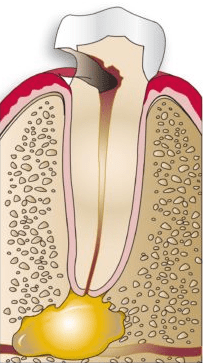
Root canals are restorative dental procedures that are necessary to treat a pulp infection. Pulp infections occur when decay-causing bacteria find their way inside the tooth. In most cases, this occurs as a result of an untreated dental cavity that has eroded through the enamel and dentin layers to reach the innermost pulp layer. Pulp infections can also occur if a tooth is badly damaged or if another neighboring tooth is infected.
Once the dental pulp has been infected, this infection will continue to spread throughout the pulp chamber and root canals. A severe pulp infection can result in an abscess, more infected teeth, and even tooth loss. To prevent these complications, the infected pulp tissue is completely removed from the inside of the tooth. Removing the tooth’s nerve also eliminates any pain caused by the infection.
Unfortunately, only a general dentist can diagnose a pulp infection. If a pulp infection is present, a root canal will be needed. Some common signs that could indicate a possible pulp infection and the need for a root canal include:
This is one of the more telling symptoms of a pulp infection. Although pulp infections can begin without causing pain, as the infection progresses it causes the inner tissues to swell. This causes pressure inside the tooth and against the tooth’s nerve, which results in tooth pain. This pain is generally described as a sudden pain that continues to get worse over time. It can get worse when chewing or biting, or applying any type of pressure to the tooth. Tooth pain can also take the form of tooth sensitivity to hot, cold, and sugary foods or beverages. However, tooth pain can have a variety of causes, so it does not necessarily mean you have a pulp infection.
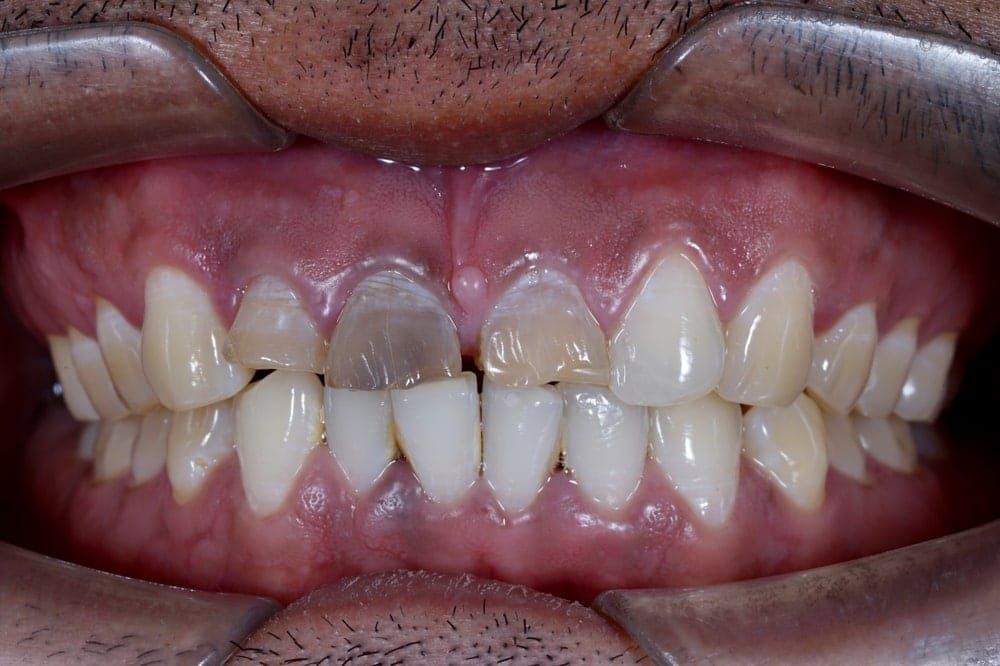
When the dental pulp is infected, it will begin to die and decay. When enough tissue is dead, this can cause the tooth to change color. Depending on how much tissue has died, this color change can be subtle or more noticeable. Discolored teeth can be yellower, greyer, light brown, or black. The key with discoloration is to look for only a single tooth that does not match the others.
Due to the close proximity of the teeth and gums, an infected tooth may pass its bacteria to the surrounding gum tissue. If the gum tissue becomes infected, then it will bleed easily, become red and swollen, and be tender to the touch. In more severe cases of infections, small gum pimples or abscesses may form as well.
In conclusion, although tooth pain, discoloration, and gum problems are common indicators of a pulp infection, the need for a root canal can only be diagnosed by your general dentist. Nevertheless, these three key symptoms are signs that you should make an appointment immediately to prevent the condition from worsening. At your appointment, if your dentist diagnoses a pulp infection, then you can expect that a root canal will be needed.

Dr. Sadati possesses extensive experience in all aspects of advanced restorative dentistry, with an emphasis in cosmetic and implant dentistry. He has attained Accredited Fellow status in the American Academy of Cosmetic Dentistry (AACD), the most rigorous, demanding credentialing process in the world. He is the only AACD Accredited Fellow in South Florida.
In order to live healthy lives, most of us are aware that eating a balanced diet and exercising regularly are important daily habits. However, what about brushing and flossing? According to a study by US News, only 30% of Americans floss daily. And yet, brushing and flossing are just as important to living a healthy life as diet and exercise.

Dental hygiene practices include brushing your teeth twice a day and flossing once a day. Another important dental hygiene practice is regular dental cleanings performed by your general dentist every six months. All these hygiene practices remove excess plaque and bacteria from the surfaces of your teeth.
Many people don’t realize just how important these dental hygiene practices are. This is evident when you consider the fact that only 30% of Americans floss daily. Unfortunately, not practicing dental hygiene can have consequences to both your oral and overall health.
Dental hygiene is important to your oral health for the simple fact that it removes excess plaque and bacteria from your mouth. The excess bacteria that resides in dental plaque is responsible for two of the most common dental problems: tooth decay and gum disease.
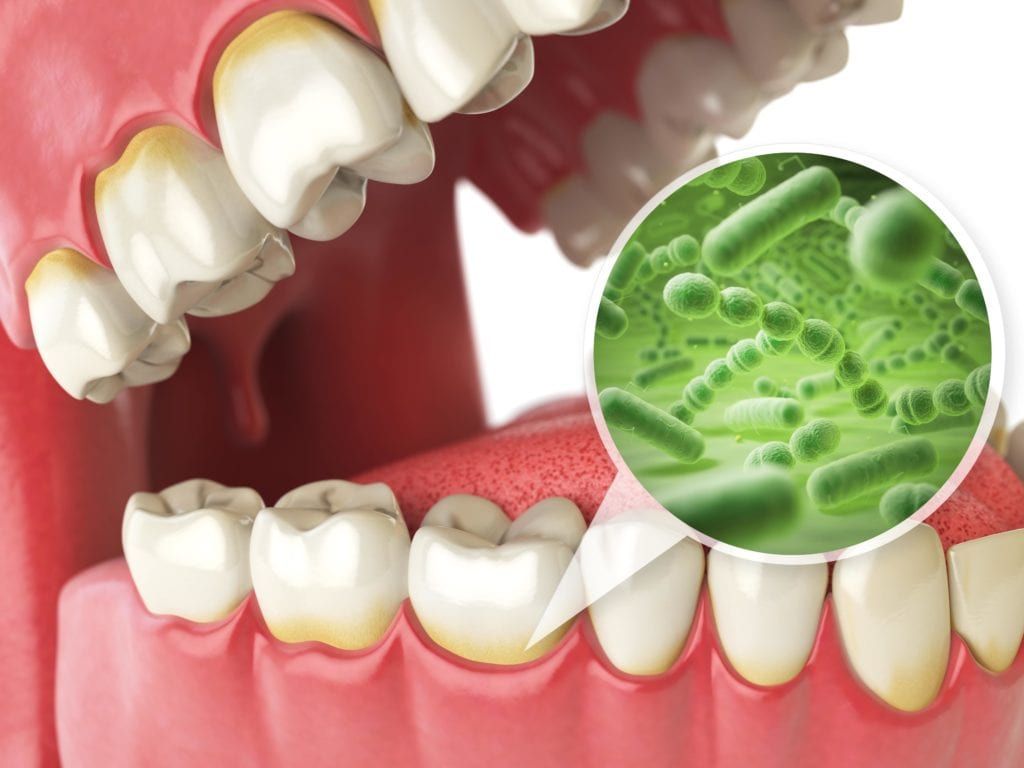
Tooth decay occurs when the waste products from bacteria concentrate in one area and erode the enamel. The erosion of tooth enamel causes the tooth to become demineralized, which can eventually lead to the formation of a dental cavity. An untreated dental cavity will continue to grow until it has reached the innermost layer of the tooth. Once the dental pulp has been infected, the only way to save the tooth is with a root canal.
Gum disease occurs when excess plaque accumulates in the gum pockets along the barrier between the gums and the teeth. The bacteria contained in dental plaque essentially infects the gum tissue and causes the gums to become inflamed. When left untreated, the gums will begin to pull away from the teeth in a process known as gum recession. In its most severe form, gum disease can even cause the loss of bone tissue.
By removing excess plaque, dental hygiene reduces the risk of these problems occurring, as well as minimizes the severity if they are to occur. Since both tooth decay and gum disease can eventually lead to tooth loss, dental hygiene is important because it preserves your teeth by reducing the risk of these problems. Although missing teeth can be replaced, any dentist will tell you that healthy, natural teeth are always the best option.
Not only is dental hygiene important to your oral health, but it is also important to your overall health as well. Although you may think that the worst thing plaque can cause are tooth decay and gum disease, this is not the case. In fact, the bacteria found in plaque can travel through your bloodstream and affect other areas of your body.
Research has found poor oral hygiene to be associated with various health problems, including:

As you can see, dental hygiene is extremely crucial to preserving both your oral and overall health. Daily practices such as brushing and flossing, as well as semi-annual dental exams and cleanings are essential to control bacterial populations in your mouth. This, in turn, reduces your risk of developing tooth decay and gum disease, as well as a plethora of other health conditions. This gives you something to think about the next time you want to skip flossing.

Dr. Sadati possesses extensive experience in all aspects of advanced restorative dentistry, with an emphasis in cosmetic and implant dentistry. He has attained Accredited Fellow status in the American Academy of Cosmetic Dentistry (AACD), the most rigorous, demanding credentialing process in the world. He is the only AACD Accredited Fellow in South Florida.
Dental technology has rapidly advanced, leading to the introduction of various new products, all intricately designed to suit patients in need and help the dentist better diagnose dental problems earlier on. As the improvement of dental technology increases, so does the standard of dental care. One piece of equipment that is now becoming standard for dentistry offices everywhere is the intraoral camera. With companies continuously pushing the boundaries of science and technology, the intraoral camera is just one of the results of this innovation.
Intraoral cameras are tiny, digital cameras that dentist use to capture images of difficult to reach areas in the mouth. The instrument appears as an oversized pen, and the camera at the tip of the pen takes high-resolution footage or images and shows them in real-time to their patient. This detailed camera allows dentists to see the small details of the mouth that they would usually miss, such as swollen gums, teeth surfaces, and other dental issues, all while the patient is comfortably seated in their chair. These images and footage allow the dentist to zoom in and examine the photos in-depth, and also provide highly detailed medical records for future treatments.
Because of the improvements to today’s technology, intraoral cameras have become a set standard for dentists everywhere to assure patients and give them insight into their health. Intraoral cameras come with many benefits, including:
Allow Your Dentist To Work Efficiently – Originally, dentists have used extraoral dental cameras, a camera that takes pictures and footage outside of the patient’s mouth. Extraoral cameras still have continued use today, and when compared to intraoral, can take larger photos of the mouth within a specific focal range. However, extraoral cameras require retractors, mirror adjustments, and frames to be able to take the images. With intraoral cameras, they operate at faster speeds and don’t need extra equipment to function.
Give Patients Insight of their Oral Health – Intraoral cameras work not just for the dentist’s benefit but also for the patient. With the intraoral camera, patients can become interactive with their health, and see inside their mouth to better understand the symptoms they’re experiencing. Dentists will also be able to teach their patients about certain parts of their mouth, what issues they’re experiencing, and see into parts of their mouth that they’re missing when taking care of their teeth.
Provide Better Insurance Claims – For patients who want coverage for their treatment, intraoral cameras allow dentists to share these high-resolution images to their insurance providers, giving them better proof of their condition. Digital copies also help solidify insurance cases and make processing approval and payment for treatment much smoother.
Are you looking for an experienced, compassionate dentist? If you live in the Wellington, FL area, then contact The Sadati Center for Aesthetic Dentistry. Dr. Sam S. Sadati and his team will give you a personalized treatment that matters, using the latest in technology. For comprehensive dental care, contact Dr. Sadati today to schedule an appointment.
Imagine you’re sitting down on the couch after a long day with your bowl of popcorn to watch a movie. As you’re contently crunching on buttery morsels and intently watching the movie, you suddenly bite down on a kernel that managed to hide itself in your otherwise fluffy handful of exploded corn. You hear a dreadful crunch that is different than your previous crunching. Upon further inspection, you notice a crack on one of your teeth. Now what?

It is an unfortunate fact that our teeth are not indestructible and can become damaged at some point during our lifetime. Teeth can become damaged for a range of reasons, from biting down onto something hard to being hit in the face while playing sports. Luckily, a broken tooth is not the end of the world and can be easily fixed by your local dentist.
In fact when you crack or chip a tooth, you should call your dentist’s office as soon as possible to arrange an appointment to repair the tooth. You should never ignore a broken tooth because it is structurally compromised and the damage can progress. Additionally, bacteria may be able to enter a damaged tooth, which could result in a painful pulp infection requiring a root canal.
When you visit your dentist for a broken tooth, they may recommend a variety of treatment options depending on the location of the tooth, the type and severity of the damage, and your individual dental needs. While the exact treatment may vary, here is how a broken tooth is fixed by your dentist:
If the damage to the tooth is minimal, dental bonding may be advised. Dental bonding, also known as composite bonding, uses composite resin to repair the damage. This is the same dental material used for composite fillings and is most commonly used to repair chips and superficial cracks.
Another method of repairing a broken tooth is a dental crown. A dental crown is a tooth-shaped cap that is placed over the natural tooth in order to protect the tooth. Dental crowns may be used in cases where a significant amount of the tooth’s natural structure has been chipped off or if there is a deep crack in the tooth. Having a dental crown placed will protect the tooth from further damage and prevent bacteria from entering the tooth. Additionally, it will restore the shape of the broken tooth to ensure the bite or alignment of the surrounding teeth is not affected.
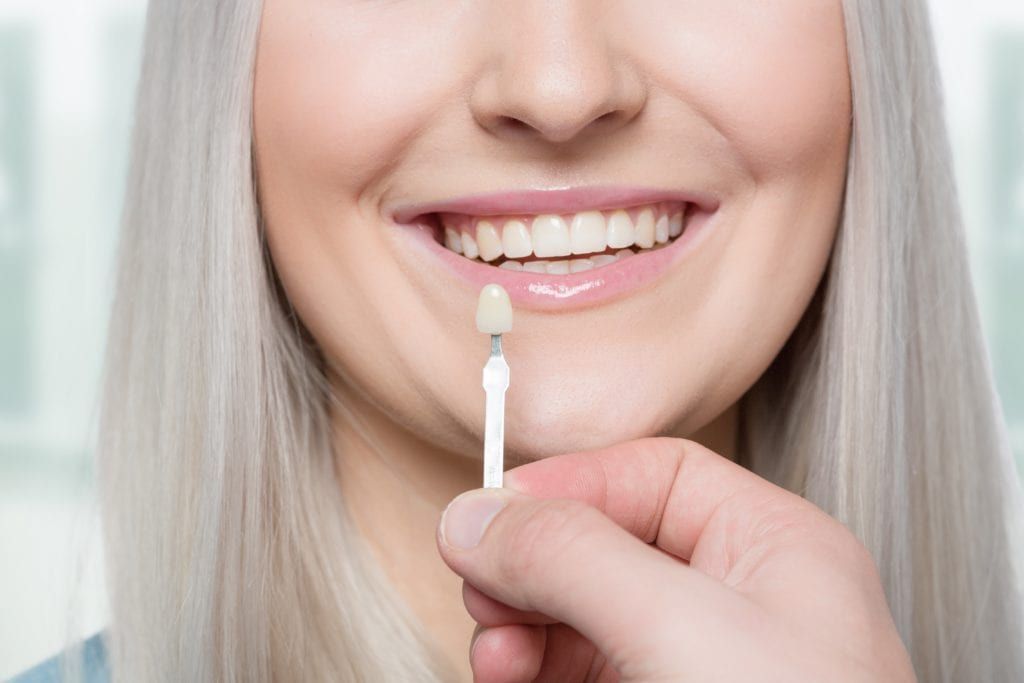
Although many people think of veneers as being purely a cosmetic dental treatment, there are certain cases where they may be used to fix a broken tooth. Veneers are thin shells that are cemented to the front surface of natural teeth. These thin shells can repair superficial tooth damage and restore the aesthetics of one’s smile. For example, veneers may be used to repair a chipped tooth or to restore the shape of a tooth who has parts that have broken off.
While nobody wants to have a broken tooth, it is reassuring to know that if it happens your dentist has you covered. However, how a broken tooth is fixed will depend on the individual case and your specific treatment plan may deviate from those mentioned above. Nevertheless, your dentist will work to restore both the function and look of a broken tooth so that you’ll be smiling again in no time.

Dr. Sadati possesses extensive experience in all aspects of advanced restorative dentistry, with an emphasis in cosmetic and implant dentistry. He has attained Accredited Fellow status in the American Academy of Cosmetic Dentistry (AACD), the most rigorous, demanding credentialing process in the world. He is the only AACD Accredited Fellow in South Florida.
If you’ve ever had a dental crown placed, you know that it is a cap that is cemented over your natural tooth. However, do you know how much tooth is needed for a crown? Chances are, probably not. Don’t feel bad though, this is not common knowledge (unless you’re a dentist!). Nevertheless, it doesn’t hurt to know how much tooth is needed for a crown so you have a better idea of what your dentist is working with.

For starters, your dentist may recommend a dental crown if you have a tooth that has a significant amount of damage or decay. In most cases, dental crowns are used to restore teeth that cannot be safely restored with a dental filling alone. For example, cases where the decay or damage spans over ¾ of the tooth.
The good news is that crowns are highly versatile in terms of how much tooth is needed. While there needs to be enough underlying structure to hold the crown in place and provide internal support, this structure does not necessarily need to be made of the natural tooth. In fact, there are other ways that your dentist can make a crown work with very minimal remaining tooth structure.
One way is to use composite resin to build up the tooth structure. Composite resin is a tooth-colored dental material that is applied in layers and then hardened in place. It is commonly used for dental fillings, as well as dental bonding. Although composite resin on its own may not be strong enough, it works well to build up a base for the dental crown.
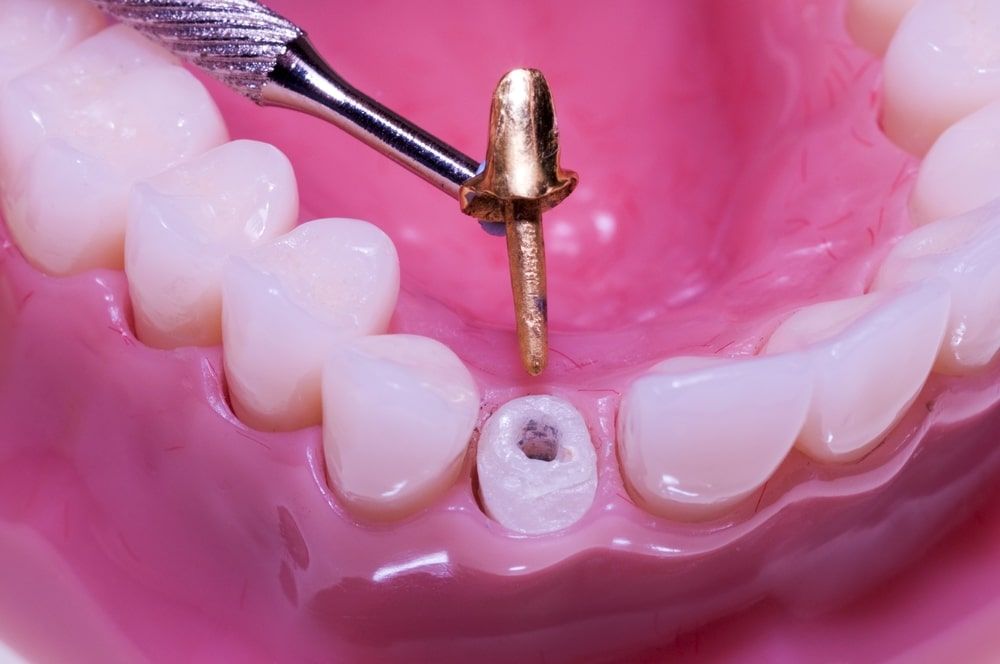
Another way to place a crown with minimal tooth structure is the post-and-core foundation. This method is used to repair significant damage or decay that has reached the dental pulp. Prior to placing the foundation, however, your dentist will perform a root canal to remove the infected or damaged tissue. This will leave the inside of your tooth hollow so an adequate foundation can be placed.
The post-and-core foundation technique fills the pulp chamber with a rubberized material called gutta percha and places a small metal post inside the tooth. The gutta-percha provides internal stability to the remaining tooth structure and the post allows for the placement of a dental crown once the tooth has been sealed.
There is also a special type of dental crown that can be used to replace a missing tooth. This type of crown is known as an implant-supported crown. Like the name suggests, a dental implant is placed to support the crown. A dental implant is an artificial tooth root implanted into the jawbone that has a metal abutment, or post, sticking out of the gums to place a dental crown.
Overall, dental crowns can generally be placed regardless of how much tooth structure is remaining. There may simply need to be some extra steps in the process to ensure there is an adequate base to support the crown. However, there are some exceptions, so you will need to speak with your dentist to determine if any of these methods are right for you.

Dr. Sadati possesses extensive experience in all aspects of advanced restorative dentistry, with an emphasis in cosmetic and implant dentistry. He has attained Accredited Fellow status in the American Academy of Cosmetic Dentistry (AACD), the most rigorous, demanding credentialing process in the world. He is the only AACD Accredited Fellow in South Florida.
Almost everyone has heard about veneers at some point in their life. In fact, veneers are one of the most commonly performed cosmetic dental procedures. If you are considering a smile makeover, you may even find yourself entertaining the idea of getting veneers. But, are veneers right for you and why should you choose veneers over the various other cosmetic dental treatments?
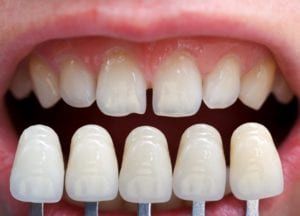
Before diving into why you should get veneers, it is important to understand what veneers are and how they work. Veneers are thin, porcelain shells that are attached to your natural teeth in order to improve their appearance. Unfortunately, veneers cannot be used to replace missing teeth and can only be applied to teeth that are free of decay. This is because veneers adhere to the teeth and your dentist does not want to trap bacteria underneath.
To place veneers, a tiny sliver of enamel must be removed from the front side of your teeth. This is a necessary step in order to ensure the veneers will sit flush with the gum line and have a natural appearance. This also prevents them from becoming damaged or falling off.
Now that you have a better idea of what veneers are and how they are applied, here are some reasons why you should get veneers:
For starters, veneers are a minimally invasive cosmetic treatment. Unlike other cosmetic procedures, veneers only require minimal amounts of the natural tooth structure to be removed from the front side only. This means that veneers preserve the majority of your natural tooth structure while adding a protective outer shell.

Since veneers are a shell that is placed over the outer surface of your teeth, they indirectly act as a shield for your teeth. This is especially beneficial if you are prone to hot and cold temperature tooth sensitivity. With veneers, the hot or cold stimuli will hit the veneer instead of your tooth enamel. This protects your tooth from feeling the sting of cold sensitivity.

Of course, the appearance of veneers is one key reason you should get them. Having veneers placed will make your smile look naturally gorgeous. In fact, many Hollywood celebrities have used veneers for their red carpet smiles.
While there are a variety of cosmetic dental treatments that can offer you a variety of cosmetic improvements, veneers are one of the few that can result in multiple improvements. A single dental veneer can be used to correct the color and shape of a tooth, as well as any damage it may have. Additionally, multiple veneers can accomplish the same thing while also making your teeth appear straighter and more evenly spaced. Not only do veneers accomplish so many improvements, but they do so with one treatment. This means no long recovery and no multiple treatments.
As you can see, there are many great reasons why you should get veneers. They are a hassle-free, minimally-invasive cosmetic dental treatment that will make your smile look phenomenal while correcting tooth sensitivity. With all these great reasons to get veneers, what are you waiting for?

Dr. Sadati possesses extensive experience in all aspects of advanced restorative dentistry, with an emphasis in cosmetic and implant dentistry. He has attained Accredited Fellow status in the American Academy of Cosmetic Dentistry (AACD), the most rigorous, demanding credentialing process in the world. He is the only AACD Accredited Fellow in South Florida.
Although cosmetic dentistry offers various methods to replace missing teeth, the best solution is always to keep your natural teeth. Maintaining your smile with proper dental hygiene and regular dental visits helps to minimize the risk of developing dental conditions that can lead to tooth loss. The two main causes of tooth loss are tooth decay and gum disease, which are both caused by excess bacteria in the mouth.
Bacteria are naturally-occurring in the mouth, however problems can arise when excess bacteria collect in plaque and tartar. In order to regulate bacteria levels, your dentist performs dental cleanings that remove plaque and tartar from the surface of your teeth. For most people, the American Dental Association recommends having a dental exam and cleaning once every six months, although some individuals may require more frequent care. During your dental exam, your dentist will examine your teeth and gums to determine what type of teeth cleaning is best suited for your dental health needs. Here are the four types of dental cleanings you may be offered:

The term prophylaxis is defined as “an action used to prevent disease”, therefore prophylaxis teeth cleanings are just dental cleanings used to prevent tooth decay and gum disease. Since bacteria populations have been found to thrive and grow in plaque and tartar, prophylaxis cleanings prevent the risk of disease by removing plaque and tartar from the surface of the teeth. During a prophylaxis cleaning, the front and back of the teeth will be cleaned, as well as the areas in between teeth. This ensures the removal of plaque and tartar from every surface of the teeth that may have been missed during usual brushing and flossing.
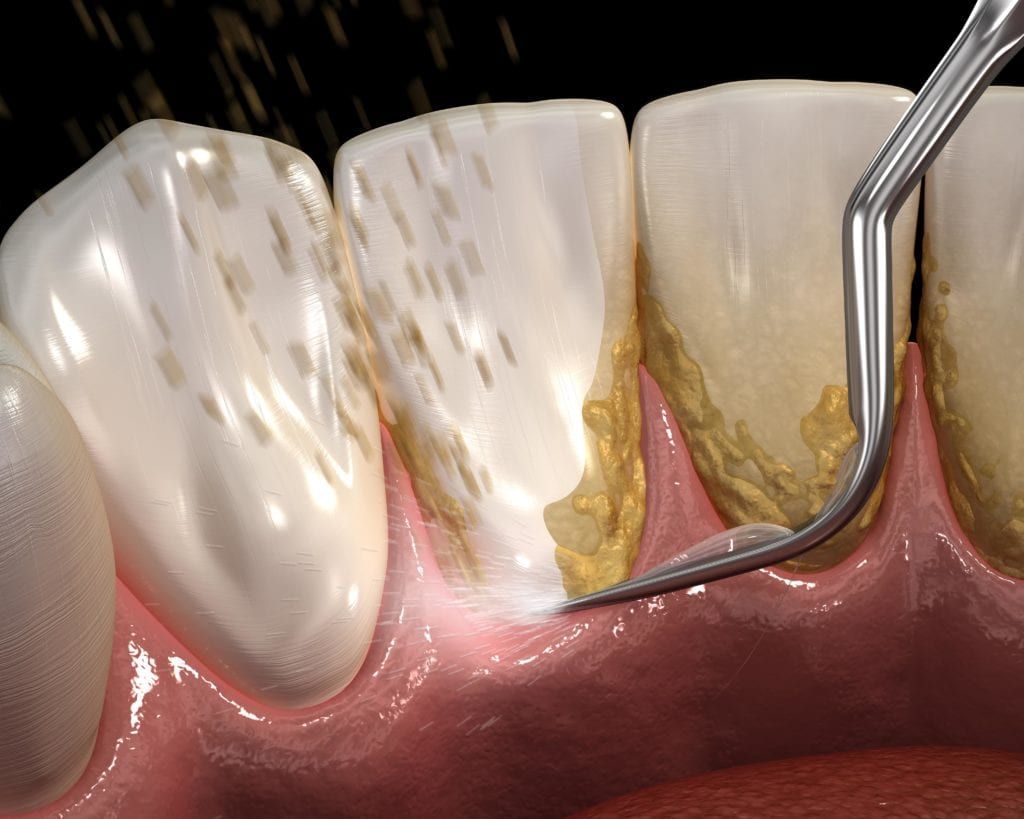

The term scaling refers to the removal of plaque and tartar from the surface of teeth, as well as from the gum pockets. Root planing refers to a process that smooths out the tooth root. When performed together, scaling and root planing function as a deep cleaning to treat gum disease. Removing plaque reduces inflammation, while smoothing the roots helps receded gums to reattach to the teeth. Severe cases of gum disease may require multiple appointments and local anesthetics to complete a scaling and root planing cleaning, however more mild cases can generally be completed comfortably in a single dental appointment.

If scaling and root planing cleanings do not eliminate gum disease, then it has likely progressed from gingivitis to periodontitis. Periodontitis is an advanced form of gum disease that cannot be cured and can eventually lead to tooth loss if not properly treated. For cases of periodontitis, periodontal maintenance cleanings are frequently needed to eliminate excess plaque, reduce gum inflammation, and halt the progression of the disease. The frequency of periodontal maintenance cleanings will vary depending on each individual case.

The term debridement refers to the removal of foreign material. In the case of a dental debridement, this is referring to the removal of excessive amounts of plaque and tartar that have become embedded in the gums and the spaces between teeth. Cases requiring dental debridement are usually from patients who have not practiced good oral hygiene or have skipped multiple teeth cleaning appointments. A debridement cleaning requires the use of a special electric tool to break up and remove tartar. Once enough has been removed, a prophylaxis cleaning will be performed to remove any remaining plaque.
Ultimately, regular teeth cleanings can help preserve your natural teeth no matter what type of cleaning they are. With that being said, having your dentist determine the right type of cleaning for your dental needs is important to maintain your oral health. Preserving your smile means taking care of your smile and knowing which type of teeth cleaning to use is part of having a lasting smile.

Dr. Sadati possesses extensive experience in all aspects of advanced restorative dentistry, with an emphasis in cosmetic and implant dentistry. He has attained Accredited Fellow status in the American Academy of Cosmetic Dentistry (AACD), the most rigorous, demanding credentialing process in the world. He is the only AACD Accredited Fellow in South Florida.
Your smile is one of the first things people notice about you and it can go a long way in making a good first impression. People who smile more often are perceived as being more friendly, honest, and attractive. For these reasons, it is highly beneficial to have a fabulous smile.
Unfortunately, not everyone is blessed with the perfect smile. Furthermore, things like age, dental habits, and decayed, damaged, or missing teeth can negatively affect the appearance of your smile. Luckily, cosmetic dentistry can easily correct these aesthetic concerns and leave you with the perfect smile. Although there are many different cosmetic treatments available, these are the top five:

Dental implants are titanium screws that are placed into the jawbone to act as artificial tooth roots. Once they fuse with the surrounding bone, dental implants are extremely strong and can support a dental prosthesis like a crown, bridge, or denture. Because of this, they are commonly used to replace a single missing tooth, multiple missing teeth, or to complete an entire full mouth rehabilitation. When it comes to function and aesthetics, dental implants are the best of both worlds. Implants are an ideal cosmetic dental treatment for those who are committed to a smile makeover and who are looking for a long-lasting solution.


Veneers are thin shells made from porcelain that are used to correct the color, size, shape, spacing, and alignment of imperfect teeth. They can be used to repair a single damaged tooth or to completely makeover an entire smile. Their ability to correct multiple concerns at once on one or more teeth is the main reason why so many people choose veneers as the best cosmetic dental treatment for them. However, it is important to note that veneers require the removal of a tiny amount of enamel, making the treatment permanent.

Teeth whitening performed by a cosmetic dentist is much different from over the counter whitening treatments. For starters, the risks are decreased and the results are increased when whitening agents are applied by a cosmetic dental professional. Professional teeth whitening only takes about 30-60 minutes, removes a variety of stains, and can whiten your teeth about 5-10 shades in a single session. For these reasons, many people are huge fans of using teeth whitening procedures to makeover their smile.


Dental crowns are placed over the crown, or visible portion of the tooth, above the gum line. They are often recommended in cases where the tooth’s natural structure has been significantly compromised by decay, cracks, or chips. Although dental crowns can improve the color, shape, and size of teeth, they also offer protection to the affected tooth as well. Crowns can also be adhered to a dental implant in order to replace a single missing tooth. During their fabrication process, dental crowns are customized to blend with the surrounding teeth.

Dental bonding is an affordable cosmetic dental procedure that can correct minor cosmetic issues. This method applies composite resin to the tooth in order to repair damage, correct structural anomalies, and improve the spacing and alignment. Bonding does not require any modification of the natural tooth structure, so it can eventually be reversed or replaced with another restoration method.
Through cosmetic dental treatments such as dental implants, veneers, teeth whitening, crowns, and bonding, an imperfect smile can easily be transformed. Each of these top five cosmetic dental treatments offers a different method to altering various aspects of your smile. To learn more and to determine which treatment can offer you the best results, schedule a consultation with your local cosmetic dentist.

Dr. Sadati possesses extensive experience in all aspects of advanced restorative dentistry, with an emphasis in cosmetic and implant dentistry. He has attained Accredited Fellow status in the American Academy of Cosmetic Dentistry (AACD), the most rigorous, demanding credentialing process in the world. He is the only AACD Accredited Fellow in South Florida.